Islamic world contributions to Medieval Europe: Difference between revisions
No edit summary |
|||
| Line 30: | Line 30: | ||
[[File:AverroesColor.jpg|thumb|[[Averroes]] was influential in the rise of [[secularism|secular thought]] in [[Western Europe]].<ref name=Fakhry/>]] |
[[File:AverroesColor.jpg|thumb|[[Averroes]] was influential in the rise of [[secularism|secular thought]] in [[Western Europe]].<ref name=Fakhry/>]] |
||
[[Avicennism]] and [[Averroism]] are terms for the revival of the [[Peripatetic school]] in medieval Europe due to the influence of Avicenna and Averroes, respectively. Avicenna was an important commentator on the works of [[Aristotle]], modifying it with his own original thinking in some areas, notably logic.<ref>"Avicenna", Lenn Evan Goodman, 2006, p. 209</ref> The main significance of Latin Avicennism lies in the interpretation of Avicennian doctrines such as the nature of the soul and his [[Essence–energies distinction|existence-essence distinction]], along with the debates and censure that they raised in [[Scholasticism|scholastic Europe]]. This was particularly the case in [[Paris]], where so-called Arabic culture was [[proscribed]] in 1210, though the influence of his [[Islamic psychological thought|psychology]] and theory of knowledge upon [[William of Auvergne, Bishop of Paris|William of Auvergne]] and [[Albertus Magnus]] have been noted.<ref>{{cite book |last=Leaman |first=Oliver |title=History of Islamic Philosophy |url=https://books.google.com/books?id=2ZnhAQAAQBAJ&pg=PA1017 |date=2013 |publisher=Routledge |isbn=978-1-136-78044-8 |pages=1017–1019}}</ref> |
[[Avicennism]] and [[Averroism]] are terms for the revival of the [[Peripatetic school]] in medieval Europe due to the influence of [[Avicenna]] and [[Averroes]], respectively. Avicenna was an important commentator on the works of [[Aristotle]], modifying it with his own original thinking in some areas, notably logic.<ref>"Avicenna", Lenn Evan Goodman, 2006, p. 209</ref> The main significance of Latin Avicennism lies in the interpretation of Avicennian doctrines such as the nature of the soul and his [[Essence–energies distinction|existence-essence distinction]], along with the debates and censure that they raised in [[Scholasticism|scholastic Europe]]. This was particularly the case in [[Paris]], where so-called Arabic culture was [[proscribed]] in 1210, though the influence of his [[Islamic psychological thought|psychology]] and theory of knowledge upon [[William of Auvergne, Bishop of Paris|William of Auvergne]] and [[Albertus Magnus]] have been noted.<ref>{{cite book |last=Leaman |first=Oliver |title=History of Islamic Philosophy |url=https://books.google.com/books?id=2ZnhAQAAQBAJ&pg=PA1017 |date=2013 |publisher=Routledge |isbn=978-1-136-78044-8 |pages=1017–1019}}</ref> |
||
The effects of Avicennism in were later submerged by the much more influential [[Averroism]], the Aristotelianism of Averroes, one of the most influential Muslim philosophers in the West.<ref>Corbin, History of Islamic Philosophy (1993), p.174</ref> Averroes disagreed with Avicenna's interpretations of Aristotle in areas such as the unity of the intellect, and it was his interpretation of Aristotle which had the most influence in medieval Europe. [[Dante Aligheri]] argues along Averroist lines for a secularist theory of the state in ''De Monarchia''.<ref name="Fakhry">Majid Fakhry (2001). ''Averroes: His Life, Works and Influence'' p. 135 Oneworld Publications. {{ISBN|1-85168-269-4}}.</ref> Averroes also developed the concept of "[[existence precedes essence]]".<ref>{{citation |first=Jones |last=Irwin |title=Averroes' Reason: A Medieval Tale of Christianity and Islam |date=Autumn 2002 |journal=The Philosopher |volume=LXXXX |issue=2}}</ref> |
The effects of Avicennism in were later submerged by the much more influential [[Averroism]], the Aristotelianism of Averroes, one of the most influential Muslim philosophers in the West.<ref>Corbin, History of Islamic Philosophy (1993), p.174</ref> Averroes disagreed with Avicenna's interpretations of Aristotle in areas such as the unity of the intellect, and it was his interpretation of Aristotle which had the most influence in medieval Europe. [[Dante Aligheri]] argues along Averroist lines for a secularist theory of the state in ''De Monarchia''.<ref name="Fakhry">Majid Fakhry (2001). ''Averroes: His Life, Works and Influence'' p. 135 Oneworld Publications. {{ISBN|1-85168-269-4}}.</ref> Averroes also developed the concept of "[[existence precedes essence]]".<ref>{{citation |first=Jones |last=Irwin |title=Averroes' Reason: A Medieval Tale of Christianity and Islam |date=Autumn 2002 |journal=The Philosopher |volume=LXXXX |issue=2}}</ref> |
||
| Line 52: | Line 52: | ||
Contributing to the growth of European science was the major search by European scholars such as Gerard of Cremona for new learning. These scholars were interested in ancient Greek philosophical and scientific texts (notably the ''[[Almagest]]'') which were not obtainable in Latin in Western Europe, but which had survived and been translated into Arabic in the Muslim world. Gerard was said to have made his way to Toledo in Spain and learnt Arabic specifically because of his "love of the ''Almagest''". While there he took advantage of the "abundance of books in Arabic on every subject".<ref>C. Burnett, "Arabic-Latin Translation Program in Toledo", p. 255.</ref> [[Al-Andalus|Islamic Spain]] and Sicily were particularly productive areas because of the proximity of multi-lingual scholars. These scholars translated many scientific and philosophical texts from [[Arabic language|Arabic]] into [[Latin]].<ref>C. H. Haskins, ''Studies in the History of Mediaeval Science'', pp.3-4</ref><ref>R. W. Southern, ''The Making of the Middle Ages'', p.65</ref> Gerard personally translated 87 books from Arabic into Latin, including the ''Almagest'', and also [[Muhammad ibn Mūsā al-Khwārizmī]]'s ''On Algebra and Almucabala'', [[Jabir ibn Aflah]]'s ''Elementa astronomica'',<ref name=Katz/> [[al-Kindi]]'s ''On Optics'', [[Ahmad ibn Muhammad ibn Kathīr al-Farghānī]]'s ''On Elements of Astronomy on the Celestial Motions'', [[al-Farabi]]'s ''On the Classification of the Sciences'',<ref>For a list of Gerard of Cremona's translations see: Edward Grant (1974) ''A Source Book in Medieval Science'', (Cambridge: Harvard Univ. Pr.), pp. 35–38 or Charles Burnett, "The Coherence of the Arabic-Latin Translation Program in Toledo in the Twelfth Century," ''Science in Context'', 14 (2001): at 249–288, at pp. 275–281.</ref> the chemical and [[Islamic medicine|medical]] works of [[Rhazes]],<ref name=Bieber/> the works of [[Thabit ibn Qurra]] and [[Hunayn ibn Ishaq]],<ref>D. Campbell, ''Arabian Medicine and Its Influence on the Middle Ages'', p. 6.</ref> and the works of [[Arzachel]], Jabir ibn Aflah, the [[Banū Mūsā]], [[Abū Kāmil Shujā ibn Aslam]], [[Abu al-Qasim al-Zahrawi]] (Abulcasis), and Ibn al-Haytham (including the ''[[Book of Optics]]''). |
Contributing to the growth of European science was the major search by European scholars such as Gerard of Cremona for new learning. These scholars were interested in ancient Greek philosophical and scientific texts (notably the ''[[Almagest]]'') which were not obtainable in Latin in Western Europe, but which had survived and been translated into Arabic in the Muslim world. Gerard was said to have made his way to Toledo in Spain and learnt Arabic specifically because of his "love of the ''Almagest''". While there he took advantage of the "abundance of books in Arabic on every subject".<ref>C. Burnett, "Arabic-Latin Translation Program in Toledo", p. 255.</ref> [[Al-Andalus|Islamic Spain]] and Sicily were particularly productive areas because of the proximity of multi-lingual scholars. These scholars translated many scientific and philosophical texts from [[Arabic language|Arabic]] into [[Latin]].<ref>C. H. Haskins, ''Studies in the History of Mediaeval Science'', pp.3-4</ref><ref>R. W. Southern, ''The Making of the Middle Ages'', p.65</ref> Gerard personally translated 87 books from Arabic into Latin, including the ''Almagest'', and also [[Muhammad ibn Mūsā al-Khwārizmī]]'s ''On Algebra and Almucabala'', [[Jabir ibn Aflah]]'s ''Elementa astronomica'',<ref name=Katz/> [[al-Kindi]]'s ''On Optics'', [[Ahmad ibn Muhammad ibn Kathīr al-Farghānī]]'s ''On Elements of Astronomy on the Celestial Motions'', [[al-Farabi]]'s ''On the Classification of the Sciences'',<ref>For a list of Gerard of Cremona's translations see: Edward Grant (1974) ''A Source Book in Medieval Science'', (Cambridge: Harvard Univ. Pr.), pp. 35–38 or Charles Burnett, "The Coherence of the Arabic-Latin Translation Program in Toledo in the Twelfth Century," ''Science in Context'', 14 (2001): at 249–288, at pp. 275–281.</ref> the chemical and [[Islamic medicine|medical]] works of [[Rhazes]],<ref name=Bieber/> the works of [[Thabit ibn Qurra]] and [[Hunayn ibn Ishaq]],<ref>D. Campbell, ''Arabian Medicine and Its Influence on the Middle Ages'', p. 6.</ref> and the works of [[Arzachel]], Jabir ibn Aflah, the [[Banū Mūsā]], [[Abū Kāmil Shujā ibn Aslam]], [[Abu al-Qasim al-Zahrawi]] (Abulcasis), and Ibn al-Haytham (including the ''[[Book of Optics]]''). |
||
During the European [[Renaissance of the 12th century]], the [[scientific method]], including the [[experiment]]al methods of [[Alhazen]] and [[Avicenna]], was introduced to medieval Europe via [[Latin translations of the 12th century|Latin translations]] of [[Arabic language|Arabic]] texts. These works influenced early European proponents of the scientific method, including [[Robert Grosseteste]]<ref>A. C. Crombie, ''Robert Grosseteste and the Origins of Experimental Science, 1100–1700'', (Oxford: Clarendon Press, 1971), pp. 52–60.</ref> and [[Roger Bacon]].<ref>{{citation |first=James S. |last=Ackerman |contribution=Leonardo's Eye |title=Journal of the Warburg & Courtauld Institutes |volume=Vol. 41 |year=1978 |page=119}}</ref> |
|||
===Alchemy=== |
===Alchemy=== |
||
| Line 58: | Line 60: | ||
Western alchemy was directly dependent upon Arabic sources.<ref>{{cite book|last=Debus|first=Allen G.|authorlink=Allen G. Debus|title=The Chemical Philosophy: Paraclesian Science and Medicine in the Sixteenth and Seventeenth Centuries|year=2002|publisher=Dover Publ.|isbn=0486421759|page=11}}</ref> The Latin [[Alchemy|alchemical]] works of "Geber" (Jābir ibn Hayyān) were standard texts for European alchemists. The exact attribution of these works remains a matter of some controversy. Some are undoubtedly translations from Arabic from works attributed to [[Jābir ibn Hayyān]], including the ''[[Kitab al-Kimya]]'' (titled ''Book of the Composition of Alchemy'' in Europe), translated by Robert of Chester (1144);<ref>Eric John Holmyard, ''Alchemy'', p.106</ref> and the ''Book of Seventy'', translated by Gerard of Cremona (before 1187).<ref>Eric John Holmyard, ''Alchemy'', p.109</ref> Whether these were actually written by one man (or whether indeed Jābir was a real historical figure) is disputed, but there is no doubting the influence on medieval European alchemy of the translated Arabic works.{{efn|A few of the Latin works are now attributed to a [[Pseudo-Geber]], as although attributed to "Geber", they have no identified Arabic source and appear to have been composed in Latin in the 13th century.<ref>Eric John Holmyard, ''Alchemy'', pp.134-135</ref>}} The alchemical works of [[Muhammad ibn Zakarīya Rāzi]] (Rhazes) were translated into Latin around the 12th century.<ref name=Bieber/> Several technical [[Influence of Arabic on other languages|Arabic words]] from Arabic alchemical works, such as ''[[alkali]]'',<ref>{{cite web|url=http://dictionary.reference.com/browse/alkali|title=the definition of alkali|author=|date=|website=Dictionary.com|accessdate=8 April 2018}}</ref> found their way into European languages and became part of scientific vocabulary. |
Western alchemy was directly dependent upon Arabic sources.<ref>{{cite book|last=Debus|first=Allen G.|authorlink=Allen G. Debus|title=The Chemical Philosophy: Paraclesian Science and Medicine in the Sixteenth and Seventeenth Centuries|year=2002|publisher=Dover Publ.|isbn=0486421759|page=11}}</ref> The Latin [[Alchemy|alchemical]] works of "Geber" (Jābir ibn Hayyān) were standard texts for European alchemists. The exact attribution of these works remains a matter of some controversy. Some are undoubtedly translations from Arabic from works attributed to [[Jābir ibn Hayyān]], including the ''[[Kitab al-Kimya]]'' (titled ''Book of the Composition of Alchemy'' in Europe), translated by Robert of Chester (1144);<ref>Eric John Holmyard, ''Alchemy'', p.106</ref> and the ''Book of Seventy'', translated by Gerard of Cremona (before 1187).<ref>Eric John Holmyard, ''Alchemy'', p.109</ref> Whether these were actually written by one man (or whether indeed Jābir was a real historical figure) is disputed, but there is no doubting the influence on medieval European alchemy of the translated Arabic works.{{efn|A few of the Latin works are now attributed to a [[Pseudo-Geber]], as although attributed to "Geber", they have no identified Arabic source and appear to have been composed in Latin in the 13th century.<ref>Eric John Holmyard, ''Alchemy'', pp.134-135</ref>}} The alchemical works of [[Muhammad ibn Zakarīya Rāzi]] (Rhazes) were translated into Latin around the 12th century.<ref name=Bieber/> Several technical [[Influence of Arabic on other languages|Arabic words]] from Arabic alchemical works, such as ''[[alkali]]'',<ref>{{cite web|url=http://dictionary.reference.com/browse/alkali|title=the definition of alkali|author=|date=|website=Dictionary.com|accessdate=8 April 2018}}</ref> found their way into European languages and became part of scientific vocabulary. |
||
===Astronomy |
===Astronomy and mathematics=== |
||
[[File:Ms.Thott.290.2º 150v.jpg|thumb|left|upright|A German manuscript page teaching use of [[Arabic numerals]] ([[Hans Talhoffer]], 1459)]] |
[[File:Ms.Thott.290.2º 150v.jpg|thumb|left|upright|A German manuscript page teaching use of [[Arabic numerals]] ([[Hans Talhoffer]], 1459)]] |
||
{{See also|Astronomy in Islam|Islamic mathematics |
{{See also|Astronomy in Islam|Islamic mathematics}} |
||
The translation of [[Muḥammad ibn Mūsā al-Khwārizmī|Al-Khwarizmi]]'s work greatly influenced mathematics in Europe. As Professor Victor J. Katz writes: "Most early algebra works in Europe in fact recognized that the first algebra works in that continent were translations of the work of al-Khwärizmï and other Islamic authors. There was also some awareness that much of plane and spherical trigonometry could be attributed to Islamic authors".<ref name="katz" /> The words [[algorithm]], deriving from Al-Khwarizmi's Latinized name Algorismi, and algebra, deriving from the title of his AD 820 book ''Hisab al-jabr w’al-muqabala, Kitab al-Jabr wa-l-Muqabala'' are themselves [[List of Arabic loanwords in English|Arabic loanwords]]. This and other Arabic astronomical and mathematical works, such as those by [[Muhammad ibn Jābir al-Harrānī al-Battānī|al-Battani]]<ref name=Katz/> and [[Muhammad al-Fazari]]'s ''Great Sindhind'' (based on the ''[[Surya Siddhanta]]'' and the works of [[Brahmagupta]]).<ref>G. G. Joseph, ''The Crest of the Peacock'', p. 306</ref> were translated into Latin during the 12th century.<ref>{{cite web |last=Gill |first=M. |year=2005 |title=Was Muslim Astronomy the Harbinger of Copernicanism? |url=http://www.chowk.com/articles/9489 |accessdate=2008-01-22 |archiveurl=https://web.archive.org/web/20080102034220/http://www.chowk.com/articles/9489 |archivedate=2 January 2008 |deadurl=yes}}</ref> |
The translation of [[Muḥammad ibn Mūsā al-Khwārizmī|Al-Khwarizmi]]'s work greatly influenced mathematics in Europe. As Professor Victor J. Katz writes: "Most early algebra works in Europe in fact recognized that the first algebra works in that continent were translations of the work of al-Khwärizmï and other Islamic authors. There was also some awareness that much of plane and spherical trigonometry could be attributed to Islamic authors".<ref name="katz" /> The words [[algorithm]], deriving from Al-Khwarizmi's Latinized name Algorismi, and algebra, deriving from the title of his AD 820 book ''Hisab al-jabr w’al-muqabala, Kitab al-Jabr wa-l-Muqabala'' are themselves [[List of Arabic loanwords in English|Arabic loanwords]]. This and other Arabic astronomical and mathematical works, such as those by [[Muhammad ibn Jābir al-Harrānī al-Battānī|al-Battani]]<ref name=Katz/> and [[Muhammad al-Fazari]]'s ''Great Sindhind'' (based on the ''[[Surya Siddhanta]]'' and the works of [[Brahmagupta]]).<ref>G. G. Joseph, ''The Crest of the Peacock'', p. 306</ref> were translated into Latin during the 12th century.<ref>{{cite web |last=Gill |first=M. |year=2005 |title=Was Muslim Astronomy the Harbinger of Copernicanism? |url=http://www.chowk.com/articles/9489 |accessdate=2008-01-22 |archiveurl=https://web.archive.org/web/20080102034220/http://www.chowk.com/articles/9489 |archivedate=2 January 2008 |deadurl=yes}}</ref> |
||
| Line 75: | Line 77: | ||
A short verse used by [[Fulbert of Chartres]] (952-970 –1028) to help remember some of the brightest stars in the sky gives us the earliest known use of Arabic loanwords in a Latin text:<ref>{{Citation |last=Burnett |first=Charles |title=The introduction of Arabic learning into England |year=1997 |publisher=British Library |location=London |isbn=978-0-7123-4545-3 |page=5 |edition=null}}</ref> "[[Aldebaran]] stands out in Taurus, [[Menke (star)|Menke]] and [[Rigel]] in Gemini, and Frons and bright [[Calbalazet]] in Leo. Scorpio, you have [[Galbalagrab]]; and you, Capricorn, [[Deneb]]. You, [[Batanalhaut]], are alone enough for Pisces."<ref>{{cite book |author=Fulbert of Chartres |title=The letters and poems of Fulbert of Chartres |year=1976 |publisher=Clarendon Press |location=Oxford |isbn=978-0-19-822233-0 |page=261 |url=https://books.google.com/?id=q-KL-jTReuUC&pg=PA261&dq=the+letters+and+poems+of+fulbert+of+chartres+Aldebaran+Pisces#v=onepage&q&f=false |edition=Reproduction |authorlink=Fulbert of Chartres |translator=Behrends |editor=Frederick Behrends |accessdate=14 May 2011}}</ref> |
A short verse used by [[Fulbert of Chartres]] (952-970 –1028) to help remember some of the brightest stars in the sky gives us the earliest known use of Arabic loanwords in a Latin text:<ref>{{Citation |last=Burnett |first=Charles |title=The introduction of Arabic learning into England |year=1997 |publisher=British Library |location=London |isbn=978-0-7123-4545-3 |page=5 |edition=null}}</ref> "[[Aldebaran]] stands out in Taurus, [[Menke (star)|Menke]] and [[Rigel]] in Gemini, and Frons and bright [[Calbalazet]] in Leo. Scorpio, you have [[Galbalagrab]]; and you, Capricorn, [[Deneb]]. You, [[Batanalhaut]], are alone enough for Pisces."<ref>{{cite book |author=Fulbert of Chartres |title=The letters and poems of Fulbert of Chartres |year=1976 |publisher=Clarendon Press |location=Oxford |isbn=978-0-19-822233-0 |page=261 |url=https://books.google.com/?id=q-KL-jTReuUC&pg=PA261&dq=the+letters+and+poems+of+fulbert+of+chartres+Aldebaran+Pisces#v=onepage&q&f=false |edition=Reproduction |authorlink=Fulbert of Chartres |translator=Behrends |editor=Frederick Behrends |accessdate=14 May 2011}}</ref> |
||
===Physics=== |
|||
| ⚫ | Ibn al-Haytham (Alhazen) wrote the ''Book of Optics'' (1021), in which he developed |
||
{{Main||Physics in the medieval Islamic world}} |
|||
| ⚫ | [[Ibn al-Haytham]] (Alhazen) wrote the ''[[Book of Optics]]'' (1021), in which he developed an influential theory of vision and light. He rejected [[Ptolemy]]'s theory that light was [[emission theory (vision)|emitted by the eye]], insisting instead that light rays entered the eye. Ibn al-Haytham's work on [[optics]] was the most significant advance in the field up until [[Kepler]].<ref name=Hogendijk>{{citation|last1=Sabra|first1=A. I. |author1-link=A. I. Sabra |last2=Hogendijk|first2=J. P.|year=2003|title=The Enterprise of Science in Islam: New Perspectives|pages=85–118|publisher=[[MIT Press]]|isbn=0-262-19482-1|oclc=237875424}}</ref> The ''Book of Optics'' was an important stepping stone in the [[history of the scientific method]] and [[history of optics]].<ref name=Gomati>H. Salih, M. Al-Amri, M. El Gomati (2005). "[http://unesdoc.unesco.org/images/0014/001412/141236E.pdf The Miracle of Light]", ''A World of Science'' '''3''' (3), [[UNESCO]]</ref> The [[Latin translations of the 12th century|Latin translation]] of the ''Book of Optics'' influenced the works of many later European scientists, including [[Roger Bacon]] and [[Johannes Kepler]].<ref name=Marshall>{{citation|title=Nicole Oresme on the Nature, Reflection, and Speed of Light|first=Peter|last=Marshall|journal=[[Isis (journal)|Isis]]|volume=72|issue=3|date=September 1981|pages=357–374 [367–374]|doi=10.1086/352787}}</ref><ref name=Powers>Richard Powers ([[University of Illinois]]), [http://online.physics.uiuc.edu/courses/phys199epp/fall06/Powers-NYTimes.pdf Best Idea; Eyes Wide Open] {{webarchive|url=https://web.archive.org/web/20080229172533/http://online.physics.uiuc.edu/courses/phys199epp/fall06/Powers-NYTimes.pdf |date=2008-02-29 }}, ''[[New York Times]]'', April 18, 1999.</ref> The book also influenced other aspects of European culture. In [[religion]], for example, [[John Wycliffe]], the intellectual progenitor of the [[Protestant Reformation]], referred to Alhazen in discussing the seven deadly [[sin]]s in terms of the distortions in the seven types of [[mirror]]s analyzed in ''De aspectibus''. In [[literature]], Alhazen's ''Book of Optics'' is praised in [[Guillaume de Lorris]]' ''[[Roman de la Rose]]''.<ref name=Falco-2007/> In [[art]], the ''Book of Optics'' laid the foundations for the [[Perspective (graphical)|linear perspective]] technique and may have influenced the use of optical aids in [[Renaissance]] art (see [[Hockney-Falco thesis]]).<ref name=Falco-2007>{{citation |first=Charles M. |last=Falco |title=Ibn al-Haytham and the Origins of Modern Image Analysis |date=12–15 February 2007 |publisher=International Conference on Information Sciences, Signal Processing and its Applications}}</ref> These same techniques were later employed in the maps made by European cartographers such as [[Paolo Toscanelli]] during the [[Age of Exploration]].<ref name=Powers/> |
||
The theory of motion developed by |
The theory of motion developed by [[Avicenna]] influenced [[Jean Buridan]]'s [[theory of impetus]], the ancestor of the [[inertia]] and [[momentum]] concepts.<ref>{{cite web|url=http://plato.stanford.edu/entries/buridan/notes.html#48|title=John Buridan > Notes (Stanford Encyclopedia of Philosophy)|author=|date=|website=plato.stanford.edu|accessdate=8 April 2018}}</ref> [[Hibat Allah Abu'l-Barakat al-Baghdaadi]], who proposed an early version of the fundamental law of [[classical mechanics]], that a force applied continuously produces acceleration,<ref>{{cite encyclopedia | last = Pines | first = Shlomo | title = Abu'l-Barakāt al-Baghdādī , Hibat Allah | encyclopedia = [[Dictionary of Scientific Biography]] | volume = 1 | pages = 26–28 | publisher = Charles Scribner's Sons | location = New York | year = 1970 | isbn = 0-684-10114-9 }}<br>([[cf.]] Abel B. Franco (October 2003). "Avempace, Projectile Motion, and Impetus Theory", ''Journal of the History of Ideas'' '''64''' (4), p. 521-546 [528].)</ref> influenced Jean Buridan and [[Albert of Saxony (philosopher)|Albert of Saxony]] who referred to al-Baghdaadi in explaining that the acceleration of a falling body is a result of its increasing impetus.<ref name=Gutman>{{Cite book|title=Pseudo-Avicenna, Liber Celi Et Mundi: A Critical Edition|first=Oliver|last=Gutman|publisher=[[Brill Publishers]]|year=2003|isbn=90-04-13228-7|page=193}}</ref> The work of [[Galileo Galilei]] on [[classical mechanics]] (superseding [[Aristotelian physics]]) was also influenced by earlier medieval physics writers, such as [[Avempace]],<ref>Moody, Ernest A. (1951), "Galileo and Avempace: The Dynamics of the Leaning Tower Experiment (I)", ''Journal of the History of Ideas'' '''12''' (2): 163–193</ref> who had proposed the concept of a reaction force.<ref name = "Franco">Franco, Abel B.. "Avempace, Projectile Motion, and Impetus Theory". ''Journal of the History of Ideas''. Vol. 64(4): 543.</ref> |
||
The [[magnetic compass]], a Chinese invention, is first mentioned in Arabic sources of c. 1300, by the [[Rasulid dynasty#List of Rasulid sultans|Yemeni Sultan al-Ashraf]] and by Egyptian astronomer Ibn Simʿun.<ref>{{Cite journal|title=Two Early Arabic Sources On The Magnetic Compass|first=Petra G.|last=Schmidl|journal=Journal of Arabic and Islamic Studies|year=1996–1997|volume=1|pages=81–132}}</ref> |
The [[magnetic compass]], a Chinese invention, is first mentioned in Arabic sources of c. 1300, by the [[Rasulid dynasty#List of Rasulid sultans|Yemeni Sultan al-Ashraf]] and by Egyptian astronomer Ibn Simʿun.<ref>{{Cite journal|title=Two Early Arabic Sources On The Magnetic Compass|first=Petra G.|last=Schmidl|journal=Journal of Arabic and Islamic Studies|year=1996–1997|volume=1|pages=81–132}}</ref> |
||
| Line 161: | Line 166: | ||
The production of [[sugar]] from [[sugar cane]],<ref>"The Sugar Cane Industry: An Historical Geography from Its Origins to 1914 (1989)", pp.34-34, JH Galloway, {{ISBN|0-521-02219-3}}</ref> [[water clock]]s, [[Pulp (paper)|pulp]] and [[paper]], [[silk]], and various advances in making [[perfume]], were transferred from the Islamic world to medieval Europe.<ref>[[Ahmad Y Hassan]], [http://www.history-science-technology.com/Articles/articles%207.htm Transfer Of Islamic Technology To The West, Part 1: Avenues Of Technology Transfer] {{webarchive|url=https://web.archive.org/web/20090926225939/http://www.history-science-technology.com/Articles/articles%207.htm |date=2009-09-26 }}</ref> [[Fulling]] mills and advances in mill technology may have also been transmitted from the Islamic world to medieval Europe,<ref>Adam Lucas (2006), ''Wind, Water, Work: Ancient and Medieval Milling Technology'', p. 10 & 65, BRILL, {{ISBN|90-04-14649-0}}.</ref> along with the large-scale use of inventions like the [[suction]] [[pump]],<ref>[[Ahmad Y Hassan]]. [http://www.history-science-technology.com/Notes/Notes%202.htm The Origin of the Suction Pump] {{webarchive|url=https://web.archive.org/web/20080226102543/http://www.history-science-technology.com/Notes/Notes%202.htm |date=2008-02-26 }}.</ref> [[noria]] and [[chain pump]]s for irrigation purposes. According to Watson, "The Islamic contribution was less in the invention of new devices than in the application on a much wider scale of devices which in pre-Islamic times had been used only over limited areas and to a limited extent."<ref>Quoted in "The Sugar Cane Industry: An Historical Geography from Its Origins to 1914", JH Galloway, p. 27</ref> These innovations made it possible for some industrial operations that were previously served by manual labour or draught animals to be driven by machinery in medieval Europe.<ref>Adam Robert Lucas (2005), "Industrial Milling in the Ancient and Medieval Worlds: A Survey of the Evidence for an Industrial Revolution in Medieval Europe", ''Technology and Culture'' '''46''' (1), pp. 1–30.</ref> |
The production of [[sugar]] from [[sugar cane]],<ref>"The Sugar Cane Industry: An Historical Geography from Its Origins to 1914 (1989)", pp.34-34, JH Galloway, {{ISBN|0-521-02219-3}}</ref> [[water clock]]s, [[Pulp (paper)|pulp]] and [[paper]], [[silk]], and various advances in making [[perfume]], were transferred from the Islamic world to medieval Europe.<ref>[[Ahmad Y Hassan]], [http://www.history-science-technology.com/Articles/articles%207.htm Transfer Of Islamic Technology To The West, Part 1: Avenues Of Technology Transfer] {{webarchive|url=https://web.archive.org/web/20090926225939/http://www.history-science-technology.com/Articles/articles%207.htm |date=2009-09-26 }}</ref> [[Fulling]] mills and advances in mill technology may have also been transmitted from the Islamic world to medieval Europe,<ref>Adam Lucas (2006), ''Wind, Water, Work: Ancient and Medieval Milling Technology'', p. 10 & 65, BRILL, {{ISBN|90-04-14649-0}}.</ref> along with the large-scale use of inventions like the [[suction]] [[pump]],<ref>[[Ahmad Y Hassan]]. [http://www.history-science-technology.com/Notes/Notes%202.htm The Origin of the Suction Pump] {{webarchive|url=https://web.archive.org/web/20080226102543/http://www.history-science-technology.com/Notes/Notes%202.htm |date=2008-02-26 }}.</ref> [[noria]] and [[chain pump]]s for irrigation purposes. According to Watson, "The Islamic contribution was less in the invention of new devices than in the application on a much wider scale of devices which in pre-Islamic times had been used only over limited areas and to a limited extent."<ref>Quoted in "The Sugar Cane Industry: An Historical Geography from Its Origins to 1914", JH Galloway, p. 27</ref> These innovations made it possible for some industrial operations that were previously served by manual labour or draught animals to be driven by machinery in medieval Europe.<ref>Adam Robert Lucas (2005), "Industrial Milling in the Ancient and Medieval Worlds: A Survey of the Evidence for an Industrial Revolution in Medieval Europe", ''Technology and Culture'' '''46''' (1), pp. 1–30.</ref> |
||
The process |
The process of [[alcohol distillation]] ([[liquor]]), which [[Al-Kindi]] unambiguously described in the 9th century,<ref name="hassan">[[Ahmad Y. al-Hassan]] (2001), [https://books.google.com/books?id=h2g1qte4iegC&pg=PA65 ''Science and Technology in Islam: Technology and applied sciences'', pages 65-69], [[UNESCO]]</ref><ref name=Hassan-Alcohol>{{cite web |url=http://www.history-science-technology.com/notes/notes7.html |title=Alcohol and the Distillation of Wine in Arabic Sources |accessdate=2014-04-19 |last=Hassan |first=Ahmad Y |authorlink=Ahmad Y Hassan |work=History of Science and Technology in Islam}}</ref><ref>[http://www.economist.com/node/2281757 The Economist: "Liquid fire - The Arabs discovered how to distil alcohol. They still do it best, say some"] December 18, 2003</ref> spread to Italy,<ref name="hassan"/><ref name="habib">[[Irfan Habib]] (2011), [https://books.google.com/books?id=K8kO4J3mXUAC&pg=PA55 ''Economic History of Medieval India, 1200-1500'', page 55], [[Pearson Education]]</ref> where the distillation of alcohol later appeared at the [[School of Salerno]] in southern Italy during the 12th century.<ref>{{Cite book | last= Forbes | first= Robert James | title= A short history of the art of distillation: from the beginnings up to the death of Cellier Blumenthal | year= 1970 | publisher= BRILL | pages= 57, 89 | isbn= 978-90-04-00617-1 | url= https://books.google.com/books?id=XeqWOkKYn28C | accessdate= 29 June 2010}}</ref><ref>{{Cite book | last= Sarton | first= George | title= Introduction to the history of science | year= 1975 | publisher= R. E. Krieger Pub. Co. | page= 145}}</ref> |
||
===Coinage=== |
===Coinage=== |
||
| Line 177: | Line 182: | ||
Early medieval [[universities]] in Europe are believed to have been influenced by Islamic [[madrasa]]s in [[Al-Andalus]], the [[Emirate of Sicily]], and the Middle East during the [[Crusades]].<ref>{{cite book|author=Nuria Sanz, Sjur Bergan|title=The heritage of European universities, Volume 548|url=https://books.google.com/?id=M09rKWhN3soC&printsec=frontcover&dq=The+Heritage+of+European+Universities#v=onepage&q=arab-oriental&f=false|publisher=[[Council of Europe]]|page=28|deadurl=no|archiveurl=https://web.archive.org/web/20150905161423/https://books.google.com/books?id=M09rKWhN3soC&printsec=frontcover&dq=The+Heritage+of+European+Universities&hl=en&sa=X&ei=AZ8LT6SED-Hv0gH_kImMBg&ved=0CDkQ6AEwAA#v=onepage&q=arab-oriental&f=false|archivedate=5 September 2015|isbn=9789287161215|date=1 January 2006}}</ref><ref>{{Cite journal|last=Makdisi|first=George|title=Scholasticism and Humanism in Classical Islam and the Christian West|journal=Journal of the American Oriental Society|volume=109|issue=2|date=April–June 1989|pages=175–182 [175–77]|doi=10.2307/604423|jstor=604423|bibcode=1964JAOS...84..128H}}; {{Cite journal|last=Makdisi|first=John A.|title=The Islamic Origins of the Common Law|journal=[[North Carolina Law Review]]|date=June 1999|volume=77|issue=5|pages=1635–1739}}</ref><ref>{{Cite book|title=A History of Christian-Muslim Relations|first=Hugh|last=Goddard|year=2000|publisher=[[Edinburgh University Press]]|isbn=978-0-7486-1009-9|page=99}}</ref> The influences of scholarship from the Islamic world on the universities of Western Europe are well-documented.<ref>{{Citation | editor-last = Feingold | editor-first = Mordecai | last = Lowe | first = Roy | last2 = Yasuhara | first2 = Yoshihito | chapter = The origins of higher learning: time for a new historiography? | title = History of Universities | volume = 27 | issue = 1 | pages = 1–19 | date = 2013 | publisher = Oxford University Press | location = Oxford | url = https://books.google.com/?id=iRl8AAAAQBAJ&dq=History+of+Universities:+Volume+XXVII/1 | deadurl = no | archiveurl = https://web.archive.org/web/20150905153758/https://books.google.com/books?id=iRl8AAAAQBAJ&dq=History+of+Universities%3A+Volume+XXVII%2F1&source=gbs_navlinks_s | archivedate = 5 September 2015 | df = dmy-all | isbn = 9780199685844 }}</ref> Their endowment by a prince or monarch and their role in training government officials made early [[History of the Mediterranean region|Mediterranean]] universities similar to Islamic [[madrasa]]s.<ref>{{Citation | last = Pryds | first = Darleen | editor-last = Courtenay | editor-first = William J. | editor2-last = Miethke | editor2-first = Jürgen | editor3-last = Priest | editor3-first = David B. | publication-date = 2000 | title = Universities and Schooling in Medieval Society | chapter = ''Studia'' as Royal Offices: Mediterranean Universities of Medieval Europe | series = Education and Society in the Middle Ages and Renaissance | volume = 10 | publisher = Brill | publication-place = Leiden | pages = 96–98 | url = https://www.google.com/search?tbo=p&tbm=bks&q=isbn:9004113517 }}</ref> [[Madrasa|Madaris]] and European universities in the Mediterranean region shared similar foundations by princely patrons and were intended to provide loyal administrators to further the rulers' agenda.<ref>{{Citation | last = Pryds | first = Darleen | editor-last = Courtenay | editor-first = William J. | editor2-last = Miethke | editor2-first = Jürgen | editor3-last = Priest | editor3-first = David B. | year = 2000 | title = Universities and Schooling in Medieval Society | chapter = ''Studia'' as Royal Offices: Mediterranean Universities of Medieval Europe | series = Education and Society in the Middle Ages and Renaissance | volume = 10 | publisher = Brill | publication-place = Leiden | pages = 83–99 | isbn = 978-90-04-11351-0 | issn = 0926-6070}}</ref> According to historians such as [[George Makdisi]], [[Devin J. Stewart]], [[Josef W. Meri]], and [[Shawkat Toorawa]], the [[ijazah]] issued in early Islamic [[madrasah]]s was a direct precursor to, and influenced, the [[doctorate]] later issued in medieval universities.<ref>{{citation|doi=10.2307/604423|last=Makdisi|first=George|title=Scholasticism and Humanism in Classical Islam and the Christian West|jstor=604423|journal=Journal of the American Oriental Society|volume=109|issue=2|date=April–June 1989|pages=175–182 [175–77]}}</ref><ref name="stewart">{{cite book|last=Devin J. Stewart|first=Josef W. Meri|journal=[[Medieval Islamic Civilization: An Encyclopedia]]|title=Degrees, or Ijazah|date=2005|publisher=[[Routledge]]|isbn=9781135455965|pages=201–203|url=https://books.google.com/books?id=c1ZsBgAAQBAJ&pg=PA201}}</ref> |
Early medieval [[universities]] in Europe are believed to have been influenced by Islamic [[madrasa]]s in [[Al-Andalus]], the [[Emirate of Sicily]], and the Middle East during the [[Crusades]].<ref>{{cite book|author=Nuria Sanz, Sjur Bergan|title=The heritage of European universities, Volume 548|url=https://books.google.com/?id=M09rKWhN3soC&printsec=frontcover&dq=The+Heritage+of+European+Universities#v=onepage&q=arab-oriental&f=false|publisher=[[Council of Europe]]|page=28|deadurl=no|archiveurl=https://web.archive.org/web/20150905161423/https://books.google.com/books?id=M09rKWhN3soC&printsec=frontcover&dq=The+Heritage+of+European+Universities&hl=en&sa=X&ei=AZ8LT6SED-Hv0gH_kImMBg&ved=0CDkQ6AEwAA#v=onepage&q=arab-oriental&f=false|archivedate=5 September 2015|isbn=9789287161215|date=1 January 2006}}</ref><ref>{{Cite journal|last=Makdisi|first=George|title=Scholasticism and Humanism in Classical Islam and the Christian West|journal=Journal of the American Oriental Society|volume=109|issue=2|date=April–June 1989|pages=175–182 [175–77]|doi=10.2307/604423|jstor=604423|bibcode=1964JAOS...84..128H}}; {{Cite journal|last=Makdisi|first=John A.|title=The Islamic Origins of the Common Law|journal=[[North Carolina Law Review]]|date=June 1999|volume=77|issue=5|pages=1635–1739}}</ref><ref>{{Cite book|title=A History of Christian-Muslim Relations|first=Hugh|last=Goddard|year=2000|publisher=[[Edinburgh University Press]]|isbn=978-0-7486-1009-9|page=99}}</ref> The influences of scholarship from the Islamic world on the universities of Western Europe are well-documented.<ref>{{Citation | editor-last = Feingold | editor-first = Mordecai | last = Lowe | first = Roy | last2 = Yasuhara | first2 = Yoshihito | chapter = The origins of higher learning: time for a new historiography? | title = History of Universities | volume = 27 | issue = 1 | pages = 1–19 | date = 2013 | publisher = Oxford University Press | location = Oxford | url = https://books.google.com/?id=iRl8AAAAQBAJ&dq=History+of+Universities:+Volume+XXVII/1 | deadurl = no | archiveurl = https://web.archive.org/web/20150905153758/https://books.google.com/books?id=iRl8AAAAQBAJ&dq=History+of+Universities%3A+Volume+XXVII%2F1&source=gbs_navlinks_s | archivedate = 5 September 2015 | df = dmy-all | isbn = 9780199685844 }}</ref> Their endowment by a prince or monarch and their role in training government officials made early [[History of the Mediterranean region|Mediterranean]] universities similar to Islamic [[madrasa]]s.<ref>{{Citation | last = Pryds | first = Darleen | editor-last = Courtenay | editor-first = William J. | editor2-last = Miethke | editor2-first = Jürgen | editor3-last = Priest | editor3-first = David B. | publication-date = 2000 | title = Universities and Schooling in Medieval Society | chapter = ''Studia'' as Royal Offices: Mediterranean Universities of Medieval Europe | series = Education and Society in the Middle Ages and Renaissance | volume = 10 | publisher = Brill | publication-place = Leiden | pages = 96–98 | url = https://www.google.com/search?tbo=p&tbm=bks&q=isbn:9004113517 }}</ref> [[Madrasa|Madaris]] and European universities in the Mediterranean region shared similar foundations by princely patrons and were intended to provide loyal administrators to further the rulers' agenda.<ref>{{Citation | last = Pryds | first = Darleen | editor-last = Courtenay | editor-first = William J. | editor2-last = Miethke | editor2-first = Jürgen | editor3-last = Priest | editor3-first = David B. | year = 2000 | title = Universities and Schooling in Medieval Society | chapter = ''Studia'' as Royal Offices: Mediterranean Universities of Medieval Europe | series = Education and Society in the Middle Ages and Renaissance | volume = 10 | publisher = Brill | publication-place = Leiden | pages = 83–99 | isbn = 978-90-04-11351-0 | issn = 0926-6070}}</ref> According to historians such as [[George Makdisi]], [[Devin J. Stewart]], [[Josef W. Meri]], and [[Shawkat Toorawa]], the [[ijazah]] issued in early Islamic [[madrasah]]s was a direct precursor to, and influenced, the [[doctorate]] later issued in medieval universities.<ref>{{citation|doi=10.2307/604423|last=Makdisi|first=George|title=Scholasticism and Humanism in Classical Islam and the Christian West|jstor=604423|journal=Journal of the American Oriental Society|volume=109|issue=2|date=April–June 1989|pages=175–182 [175–77]}}</ref><ref name="stewart">{{cite book|last=Devin J. Stewart|first=Josef W. Meri|journal=[[Medieval Islamic Civilization: An Encyclopedia]]|title=Degrees, or Ijazah|date=2005|publisher=[[Routledge]]|isbn=9781135455965|pages=201–203|url=https://books.google.com/books?id=c1ZsBgAAQBAJ&pg=PA201}}</ref> |
||
Several legal [[institution]]s developed by [[Sharia|Muslim jurists]] during the classical period of Islam are believed to have influenced similar legal institutions in Europe. One such institution was the ''[[Hawala]]'', an early [[informal value transfer system]], which is mentioned in texts of Islamic jurisprudence as early as the 8th century. ''Hawala'' itself later influenced the development of the [[Agency (law)|agency]] in [[common law]] and in [[Civil law (legal system)|civil laws]] such as the ''aval'' in [[Law of France|French law]] and the ''avallo'' in [[Italy|Italian]] law.<ref>{{cite journal |title=Islamic Law: Its Relation to Other Legal Systems |first=Gamal Moursi |last=Badr |journal=The American Journal of Comparative Law |volume=26 |issue=2 – Proceedings of an International Conference on Comparative Law, Salt Lake City, Utah, 24–25 February 1977 |date=Spring 1978 |pages=187–198 [196–98] |doi=10.2307/839667 |publisher=American Society of Comparative Law |jstor=839667}}</ref> The "European [[Limited partnership|commenda]]" (Islamic ''[[Qirad]]'') used in European civil law may have also originated from Islamic law.<ref name=Makdisi/> The ''[[Waqf]]'' in [[Sharia|Islamic law]], which developed during the 7th–9th centuries, bears a notable resemblance to the [[Charitable trust|trusts]] in the English [[trust law]].<ref>{{Cite journal |journal=[[University of Pennsylvania Law Review]] |volume=136 |issue=4 |date=April 1988 |pages=1231–1261 |doi=10.2307/3312162 |author1=Gaudiosi, Monica M |title=The Influence of the Islamic Law of Waqf on the Development of the Trust in England_ The Case of Merton College |publisher=The University of Pennsylvania Law Review |jstor=3312162|url=http://scholarship.law.upenn.edu/cgi/viewcontent.cgi?article=3909&context=penn_law_review}}</ref> For example, every ''Waqf'' was required to have a ''waqif'' (settlor), ''mutawillis'' (trustee), ''[[qadi]]'' (judge) and beneficiaries.<ref>{{Cite journal |journal=[[University of Pennsylvania Law Review]] |volume=136 |issue=4 |date=April 1988 |doi=10.2307/3312162 |author1=Gaudiosi, Monica M |title=The Influence of the Islamic Law of Waqf on the Development of the Trust in England_ The Case of Merton College |publisher=The University of Pennsylvania Law Review |jstor=3312162|url=http://scholarship.law.upenn.edu/cgi/viewcontent.cgi?article=3909&context=penn_law_review|pp=1237–40}}</ref> The trust law developed in [[England]] at the time of the [[Crusades]], during the 12th and 13th centuries, was introduced by Crusaders who may have been influenced by the ''Waqf'' institutions they came across in the [[Middle East]].<ref>{{Harvnb|Hudson|2003|p=32}}</ref><ref>{{Cite journal |journal=[[University of Pennsylvania Law Review]] |volume=136 |issue=4 |date=April 1988 |
Several legal [[institution]]s developed by [[Sharia|Muslim jurists]] during the classical period of Islam are believed to have influenced similar legal institutions in Europe. One such institution was the ''[[Hawala]]'', an early [[informal value transfer system]], which is mentioned in texts of Islamic jurisprudence as early as the 8th century. ''Hawala'' itself later influenced the development of the [[Agency (law)|agency]] in [[common law]] and in [[Civil law (legal system)|civil laws]] such as the ''aval'' in [[Law of France|French law]] and the ''avallo'' in [[Italy|Italian]] law.<ref>{{cite journal |title=Islamic Law: Its Relation to Other Legal Systems |first=Gamal Moursi |last=Badr |journal=The American Journal of Comparative Law |volume=26 |issue=2 – Proceedings of an International Conference on Comparative Law, Salt Lake City, Utah, 24–25 February 1977 |date=Spring 1978 |pages=187–198 [196–98] |doi=10.2307/839667 |publisher=American Society of Comparative Law |jstor=839667}}</ref> The "European [[Limited partnership|commenda]]" (Islamic ''[[Qirad]]'') used in European civil law may have also originated from Islamic law.<ref name=Makdisi/> The ''[[Waqf]]'' in [[Sharia|Islamic law]], which developed during the 7th–9th centuries, bears a notable resemblance to the [[Charitable trust|trusts]] in the English [[trust law]].<ref>{{Cite journal |journal=[[University of Pennsylvania Law Review]] |volume=136 |issue=4 |date=April 1988 |pages=1231–1261 |doi=10.2307/3312162 |author1=Gaudiosi, Monica M |title=The Influence of the Islamic Law of Waqf on the Development of the Trust in England_ The Case of Merton College |publisher=The University of Pennsylvania Law Review |jstor=3312162|url=http://scholarship.law.upenn.edu/cgi/viewcontent.cgi?article=3909&context=penn_law_review}}</ref> For example, every ''Waqf'' was required to have a ''waqif'' (settlor), ''mutawillis'' (trustee), ''[[qadi]]'' (judge) and beneficiaries.<ref>{{Cite journal |journal=[[University of Pennsylvania Law Review]] |volume=136 |issue=4 |date=April 1988 |doi=10.2307/3312162 |author1=Gaudiosi, Monica M |title=The Influence of the Islamic Law of Waqf on the Development of the Trust in England_ The Case of Merton College |publisher=The University of Pennsylvania Law Review |jstor=3312162|url=http://scholarship.law.upenn.edu/cgi/viewcontent.cgi?article=3909&context=penn_law_review|pp=1237–40}}</ref> The trust law developed in [[England]] at the time of the [[Crusades]], during the 12th and 13th centuries, was introduced by Crusaders who may have been influenced by the ''Waqf'' institutions they came across in the [[Middle East]].<ref>{{Harvnb|Hudson|2003|p=32}}</ref><ref>{{Cite journal |journal=[[University of Pennsylvania Law Review]] |volume=136 |issue=4 |date=April 1988 |doi=10.2307/3312162 |author1=Gaudiosi, Monica M |title=The Influence of the Islamic Law of Waqf on the Development of the Trust in England_ The Case of Merton College |publisher=The University of Pennsylvania Law Review |jstor=3312162|url=http://scholarship.law.upenn.edu/cgi/viewcontent.cgi?article=3909&context=penn_law_review|pages=1244–45}}</ref> |
||
The Islamic ''lafif'' was a body of twelve members drawn from the [[neighbourhood]] and sworn to tell the truth, who were bound to give a unanimous [[verdict]], about matters "which they had personally seen or heard, binding on the [[Qadi|judge]], to settle the truth concerning facts in a case, between ordinary people, and obtained as of right by the [[plaintiff]]." According to Professor John Makdisi, "no other institution in any legal institution studied to date shares all of these characteristics with the English [[jury]]." It is thus likely that the concept of the ''lafif'' may have been introduced to [[England]] by the [[Normans]], who [[Norman conquest of England|conquered both England]] and the [[Emirate of Sicily]], and then evolved into the modern English jury.<ref name=Makdisi>{{Cite journal |
The Islamic ''lafif'' was a body of twelve members drawn from the [[neighbourhood]] and sworn to tell the truth, who were bound to give a unanimous [[verdict]], about matters "which they had personally seen or heard, binding on the [[Qadi|judge]], to settle the truth concerning facts in a case, between ordinary people, and obtained as of right by the [[plaintiff]]." According to Professor John Makdisi, "no other institution in any legal institution studied to date shares all of these characteristics with the English [[jury]]." It is thus likely that the concept of the ''lafif'' may have been introduced to [[England]] by the [[Normans]], who [[Norman conquest of England|conquered both England]] and the [[Emirate of Sicily]], and then evolved into the modern English jury.<ref name=Makdisi>{{Cite journal |last=Makdisi|first=John A.|title=The Islamic Origins of the Common Law |journal=[[North Carolina Law Review]] |date=June 1999 |volume=77 |issue=5 |pages=1635–1739}}</ref> |
||
==Literature== |
==Literature== |
||
{{Further information|Islamic literature|Arabic literature|Persian literature}} |
{{Further information|Islamic literature|Arabic literature|Persian literature}} |
||
It was first suggested by [[Miguel Asín Palacios]] in 1919 that [[Dante Alighieri]]'s ''[[Divine Comedy]]'', considered the greatest epic of [[Italian literature]], derived many features of and episodes about the hereafter directly or indirectly from Arabic works on [[Islamic eschatology]], such as the ''[[Hadith]]'' and the spiritual writings of [[Ibn Arabi]]. The ''[[Kitab al-Miraj]]'', concerning [[Muhammad]]'s ascension to Heaven, was translated into Latin in 1264 or shortly before<ref name="Heullant">I. Heullant-Donat and M.-A. Polo de Beaulieu, "Histoire d'une traduction," in ''Le Livre de l'échelle de Mahomet'', Latin edition and French translation by Gisèle Besson and Michèle Brossard-Dandré, Collection ''Lettres Gothiques'', Le Livre de Poche, 1991, p. 22 with note 37.</ref> as ''Liber Scale Machometi'', "The Book of Muhammad's Ladder". Dante was certainly aware of Muslim philosophy, naming Avicenna and Averroes last in his list of non-Christian philosophers in Limbo, alongside the great Greek and Latin philosophers.<ref>{{cite web|url=http://www.muslimphilosophy.com/ip/tud.htm|title=Paul A. (Paul Arthur) Cantor - The Uncanonical Dante: The Divine |
It was first suggested by [[Miguel Asín Palacios]] in 1919 that [[Dante Alighieri]]'s ''[[Divine Comedy]]'', considered the greatest epic of [[Italian literature]], derived many features of and episodes about the hereafter directly or indirectly from Arabic works on [[Islamic eschatology]], such as the ''[[Hadith]]'' and the spiritual writings of [[Ibn Arabi]]. The ''[[Kitab al-Miraj]]'', concerning [[Muhammad]]'s ascension to Heaven, was translated into Latin in 1264 or shortly before<ref name="Heullant">I. Heullant-Donat and M.-A. Polo de Beaulieu, "Histoire d'une traduction," in ''Le Livre de l'échelle de Mahomet'', Latin edition and French translation by Gisèle Besson and Michèle Brossard-Dandré, Collection ''Lettres Gothiques'', Le Livre de Poche, 1991, p. 22 with note 37.</ref> as ''Liber Scale Machometi'', "The Book of Muhammad's Ladder". Dante was certainly aware of Muslim philosophy, naming Avicenna and Averroes last in his list of non-Christian philosophers in Limbo, alongside the great Greek and Latin philosophers.<ref>{{cite web|url=http://www.muslimphilosophy.com/ip/tud.htm|title=Paul A. (Paul Arthur) Cantor - The Uncanonical Dante: The Divine Comedy and Islamic Philosophy - Philosophy and Literature 20:1|author=|date=|website=www.muslimphilosophy.com|accessdate=8 April 2018}}</ref><ref>{{cite web|url=http://en.wikisource.org/wiki/The_Divine_Comedy/Inferno/Canto_IV|title=The Divine Comedy|first=Dante|last=Alighieri|date=|publisher=|accessdate=8 April 2018|via=Wikisource}}</ref> How strong the similarities are to ''Kitab al-Miraj'' remains a matter of scholarly debate however, with no clear evidence that Dante was in fact influenced. |
||
Comedy and Islamic Philosophy - Philosophy and Literature 20:1|author=|date=|website=www.muslimphilosophy.com|accessdate=8 April 2018}}</ref><ref>{{cite web|url=http://en.wikisource.org/wiki/The_Divine_Comedy/Inferno/Canto_IV|title=The Divine Comedy|first=Dante|last=Alighieri|date=|publisher=|accessdate=8 April 2018|via=Wikisource}}</ref> How strong the similarities are to ''Kitab al-Miraj'' remains a matter of scholarly debate however, with no clear evidence that Dante was in fact influenced. |
|||
==See also== |
==See also== |
||
Revision as of 23:09, 18 April 2019
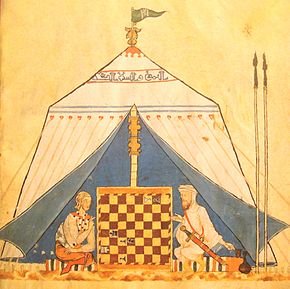
During the high medieval period, the Islamic world was at its cultural peak, supplying information and ideas to Europe, via Andalusia, Sicily and the Crusader kingdoms in the Levant. These included Latin translations of the Greek Classics and of Arabic texts in astronomy, mathematics, science, and medicine. Other contributions included technological and scientific innovations via the Silk Road, including Chinese inventions such as paper and gunpowder.
The Islamic world also influenced other aspects of medieval European culture, partly by original innovations made during the Islamic Golden Age, including various fields such as the arts, agriculture, alchemy, music, pottery, etc.
Many Arabic loanwords in Western European languages, including English, mostly via Old French, date from this period.[2] This includes traditional star names such as Aldebaran, scientific terms like alchemy (whence also chemistry), algebra, algorithm, etc. and names of commodities such as sugar, camphor, cotton, coffee, etc.
Transmission routes
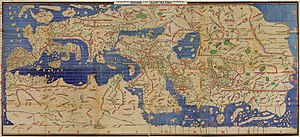
Europe and the Islamic lands had multiple points of contact during the Middle Ages. The main points of transmission of Islamic knowledge to Europe lay in Sicily and in Spain, particularly in Toledo (with Gerard of Cremone, 1114–1187, following the conquest of the city by Spanish Christians in 1085). In Sicily, following the Islamic conquest of the island in 965 and its reconquest by the Normans in 1091, a syncretistic Norman-Arab-Byzantine culture developed, exemplified by rulers such as King Roger II, who had Islamic soldiers, poets and scientists at his court. The Moroccan Muhammad al-Idrisi wrote The Book of Pleasant Journeys into Faraway Lands or Tabula Rogeriana, one of the greatest geographical treatises of the Middle Ages, for Roger.[3]
The Crusades also intensified exchanges between Europe and the Levant, with the Italian maritime republics taking a major role in these exchanges. In the Levant, in such cities as Antioch, Arab and Latin cultures intermixed intensively.[4]
During the 11th and 12th centuries, many Christian scholars travelled to Muslim lands to learn sciences. Notable examples include Leonardo Fibonacci (c. 1170 –c. 1250), Adelard of Bath (c. 1080–c. 1152) and Constantine the African (1017–1087). From the 11th to the 14th centuries, numerous European students attended Muslim centers of higher learning (which the author calls "universities") to study medicine, philosophy, mathematics, cosmography and other subjects.[5]
Aristotelianism and other philosophies

In the Middle East, many classical Greek texts, especially the works of Aristotle, were translated into Syriac during the 6th and 7th centuries by Nestorian, Melkite or Jacobite monks living in Palestine, or by Greek exiles from Athens or Edessa who visited Islamic centres of higher learning. The Islamic world then kept, translated, and developed many of these texts, especially in centers of learning such as Baghdad, where a "House of Wisdom" with thousands of manuscripts existed as early as 832. These texts were in turn translated into Latin by scholars such as Michael Scot (who made translations of Historia Animalium and On the Soul as well as of Averroes's commentaries)[6] during the Middle Ages.[1] Eastern Christians played an important role in exploiting this knowledge, especially through the Christian Aristotelian School of Baghdad in the 11th and 12th centuries.
Later Latin translations of these texts originated in multiple places. Toledo, Spain (with Gerard of Cremona's Almagest) and Sicily became the main points of transmission of knowledge from the Islamic world to Europe.[7] Burgundio of Pisa (died 1193) discovered lost texts of Aristotle in Antioch and translated them into Latin.
From Islamic Spain, the Arabic philosophical literature was translated into Hebrew, Latin, and Ladino. The Jewish philosopher Moses Maimonides, Muslim sociologist-historian Ibn Khaldun, Carthage citizen Constantine the African who translated Greek medical texts, and Al-Khwarizmi's collation of mathematical techniques were important figures of the Golden Age.
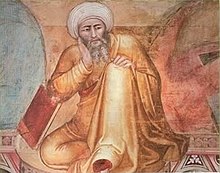
Avicennism and Averroism are terms for the revival of the Peripatetic school in medieval Europe due to the influence of Avicenna and Averroes, respectively. Avicenna was an important commentator on the works of Aristotle, modifying it with his own original thinking in some areas, notably logic.[9] The main significance of Latin Avicennism lies in the interpretation of Avicennian doctrines such as the nature of the soul and his existence-essence distinction, along with the debates and censure that they raised in scholastic Europe. This was particularly the case in Paris, where so-called Arabic culture was proscribed in 1210, though the influence of his psychology and theory of knowledge upon William of Auvergne and Albertus Magnus have been noted.[10]
The effects of Avicennism in were later submerged by the much more influential Averroism, the Aristotelianism of Averroes, one of the most influential Muslim philosophers in the West.[11] Averroes disagreed with Avicenna's interpretations of Aristotle in areas such as the unity of the intellect, and it was his interpretation of Aristotle which had the most influence in medieval Europe. Dante Aligheri argues along Averroist lines for a secularist theory of the state in De Monarchia.[8] Averroes also developed the concept of "existence precedes essence".[12]

Al-Ghazali also had an important influence on medieval Christian philosopher along with Jewish thinkers like Maimonides.[14]
George Makdisi (1989) has suggested that two particular aspects of Renaissance humanism have their roots in the medieval Islamic world, the "art of dictation, called in Latin, ars dictaminis," and "the humanist attitude toward classical language". He notes that dictation was a necessary part of Arabic scholarship (where the vowel sounds need to be added correctly based on the spoken word), and argues that the medieval Italian use of the term "ars dictaminis" makes best sense in this context. He also believes that the medieval humanist favouring of classical Latin over medieval Latin makes most sense in the context of a reaction to Arabic scholarship, with its study of the classical Arabic of the Koran in preference to medieval Arabic.[15]
Sciences
During the Islamic Golden Age, certain advances were made in scientific fields, notably in mathematics and astronomy (algebra, spherical trigonometry), and in chemistry, etc. which were later also transmitted to the West.[1][16]
Stefan of Pise translated into Latin around 1127 an Arab manual of medical theory. The method of algorism for performing arithmetic with Indian-Arabic numerals was developed by the Persian al-Khwarizmi in the 9th century, and introduced in Europe by Leonardo Fibonacci (1170–1250).[17] A translation by Robert of Chester of the Algebra by al-Kharizmi is known as early as 1145. Ibn al-Haytham (Alhazen, 980–1037) compiled treatises on optical sciences, which were used as references by Newton and Descartes. Medical sciences were also highly developed in Islam as testified by the Crusaders, who relied on Arab doctors on numerous occasions. Joinville reports he was saved in 1250 by a “Saracen” doctor.[18]
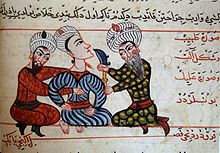
Contributing to the growth of European science was the major search by European scholars such as Gerard of Cremona for new learning. These scholars were interested in ancient Greek philosophical and scientific texts (notably the Almagest) which were not obtainable in Latin in Western Europe, but which had survived and been translated into Arabic in the Muslim world. Gerard was said to have made his way to Toledo in Spain and learnt Arabic specifically because of his "love of the Almagest". While there he took advantage of the "abundance of books in Arabic on every subject".[19] Islamic Spain and Sicily were particularly productive areas because of the proximity of multi-lingual scholars. These scholars translated many scientific and philosophical texts from Arabic into Latin.[20][21] Gerard personally translated 87 books from Arabic into Latin, including the Almagest, and also Muhammad ibn Mūsā al-Khwārizmī's On Algebra and Almucabala, Jabir ibn Aflah's Elementa astronomica,[22] al-Kindi's On Optics, Ahmad ibn Muhammad ibn Kathīr al-Farghānī's On Elements of Astronomy on the Celestial Motions, al-Farabi's On the Classification of the Sciences,[23] the chemical and medical works of Rhazes,[24] the works of Thabit ibn Qurra and Hunayn ibn Ishaq,[25] and the works of Arzachel, Jabir ibn Aflah, the Banū Mūsā, Abū Kāmil Shujā ibn Aslam, Abu al-Qasim al-Zahrawi (Abulcasis), and Ibn al-Haytham (including the Book of Optics).
During the European Renaissance of the 12th century, the scientific method, including the experimental methods of Alhazen and Avicenna, was introduced to medieval Europe via Latin translations of Arabic texts. These works influenced early European proponents of the scientific method, including Robert Grosseteste[26] and Roger Bacon.[27]
Alchemy
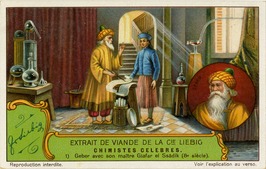
Western alchemy was directly dependent upon Arabic sources.[28] The Latin alchemical works of "Geber" (Jābir ibn Hayyān) were standard texts for European alchemists. The exact attribution of these works remains a matter of some controversy. Some are undoubtedly translations from Arabic from works attributed to Jābir ibn Hayyān, including the Kitab al-Kimya (titled Book of the Composition of Alchemy in Europe), translated by Robert of Chester (1144);[29] and the Book of Seventy, translated by Gerard of Cremona (before 1187).[30] Whether these were actually written by one man (or whether indeed Jābir was a real historical figure) is disputed, but there is no doubting the influence on medieval European alchemy of the translated Arabic works.[a] The alchemical works of Muhammad ibn Zakarīya Rāzi (Rhazes) were translated into Latin around the 12th century.[24] Several technical Arabic words from Arabic alchemical works, such as alkali,[32] found their way into European languages and became part of scientific vocabulary.
Astronomy and mathematics

The translation of Al-Khwarizmi's work greatly influenced mathematics in Europe. As Professor Victor J. Katz writes: "Most early algebra works in Europe in fact recognized that the first algebra works in that continent were translations of the work of al-Khwärizmï and other Islamic authors. There was also some awareness that much of plane and spherical trigonometry could be attributed to Islamic authors".[33] The words algorithm, deriving from Al-Khwarizmi's Latinized name Algorismi, and algebra, deriving from the title of his AD 820 book Hisab al-jabr w’al-muqabala, Kitab al-Jabr wa-l-Muqabala are themselves Arabic loanwords. This and other Arabic astronomical and mathematical works, such as those by al-Battani[22] and Muhammad al-Fazari's Great Sindhind (based on the Surya Siddhanta and the works of Brahmagupta).[34] were translated into Latin during the 12th century.[35]

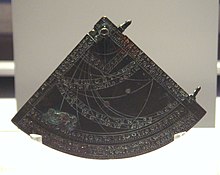
Al-Khazini's Zij as-Sanjari (1115–1116) was translated into Greek by Gregory Choniades in the 13th century and was studied in the Byzantine Empire.[36] The astronomical modifications to the Ptolemaic model made by al-Battani and Averroes led to non-Ptolemaic models produced by Mo'ayyeduddin Urdi (Urdi lemma), Nasīr al-Dīn al-Tūsī (Tusi-couple) and Ibn al-Shatir, which were later adapted into the Copernican heliocentric model. Abū al-Rayhān al-Bīrūnī's Ta'rikh al-Hind and Kitab al-qanun al-Mas’udi were translated into Latin as Indica and Canon Mas’udicus respectively.
Fibonacci presented the first complete European account of Arabic numerals and the Hindu-Arabic numeral system in his Liber Abaci (1202).[24]
Al-Jayyani's The book of unknown arcs of a sphere (a treatise on spherical trigonometry) had a "strong influence on European mathematics".[37] Regiomantus' On Triangles (c. 1463) certainly took his material on spherical trigonometry (without acknowledgement) from Arab sources. Much of the material was taken from the 12th-century work of Jabir ibn Aflah, as noted in the 16th century by Gerolamo Cardano.[33]
A short verse used by Fulbert of Chartres (952-970 –1028) to help remember some of the brightest stars in the sky gives us the earliest known use of Arabic loanwords in a Latin text:[38] "Aldebaran stands out in Taurus, Menke and Rigel in Gemini, and Frons and bright Calbalazet in Leo. Scorpio, you have Galbalagrab; and you, Capricorn, Deneb. You, Batanalhaut, are alone enough for Pisces."[39]
Physics
Ibn al-Haytham (Alhazen) wrote the Book of Optics (1021), in which he developed an influential theory of vision and light. He rejected Ptolemy's theory that light was emitted by the eye, insisting instead that light rays entered the eye. Ibn al-Haytham's work on optics was the most significant advance in the field up until Kepler.[40] The Book of Optics was an important stepping stone in the history of the scientific method and history of optics.[41] The Latin translation of the Book of Optics influenced the works of many later European scientists, including Roger Bacon and Johannes Kepler.[42][43] The book also influenced other aspects of European culture. In religion, for example, John Wycliffe, the intellectual progenitor of the Protestant Reformation, referred to Alhazen in discussing the seven deadly sins in terms of the distortions in the seven types of mirrors analyzed in De aspectibus. In literature, Alhazen's Book of Optics is praised in Guillaume de Lorris' Roman de la Rose.[44] In art, the Book of Optics laid the foundations for the linear perspective technique and may have influenced the use of optical aids in Renaissance art (see Hockney-Falco thesis).[44] These same techniques were later employed in the maps made by European cartographers such as Paolo Toscanelli during the Age of Exploration.[43]
The theory of motion developed by Avicenna influenced Jean Buridan's theory of impetus, the ancestor of the inertia and momentum concepts.[45] Hibat Allah Abu'l-Barakat al-Baghdaadi, who proposed an early version of the fundamental law of classical mechanics, that a force applied continuously produces acceleration,[46] influenced Jean Buridan and Albert of Saxony who referred to al-Baghdaadi in explaining that the acceleration of a falling body is a result of its increasing impetus.[47] The work of Galileo Galilei on classical mechanics (superseding Aristotelian physics) was also influenced by earlier medieval physics writers, such as Avempace,[48] who had proposed the concept of a reaction force.[49]
The magnetic compass, a Chinese invention, is first mentioned in Arabic sources of c. 1300, by the Yemeni Sultan al-Ashraf and by Egyptian astronomer Ibn Simʿun.[50]
Other notable works include those of Nur Ed-Din Al Betrugi, notably On the Motions of the Heavens,[24][51] Abu Mashar's Introduction to Astrology,[52] Abū Kāmil Shujā ibn Aslam's Algebra,[22] and De Proprietatibus Elementorum, an Arabic work on geology written by a pseudo-Aristotle.[24] B
Medicine
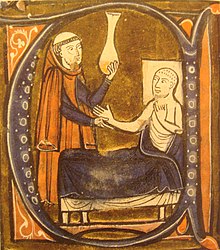

One of the most important medical works to be translated was Avicenna's The Canon of Medicine (1025), which was translated into Latin and then disseminated in manuscript and printed form throughout Europe. It remained a standard medical textbook in Europe until the early modern period, and during the 15th and 16th centuries alone, The Canon of Medicine was published more than thirty-five times.[54] Avicenna noted the contagious nature of some infectious diseases (which he attributed to "traces" left in the air by a sick person), and discussed how to effectively test new medicines.[55] He also wrote The Book of Healing, a more general encyclopedia of science and philosophy, which became another popular textbook in Europe. Muhammad ibn Zakarīya Rāzi) wrote the Comprehensive Book of Medicine, with its careful description of and distinction between measles and smallpox, which was also influential in Europe. Abu al-Qasim al-Zahrawi wrote Kitab al-Tasrif, an encyclopedia of medicine which was particularly famed for its section on surgery. It included descriptions and diagrams of over 200 surgical instruments, many of which he developed. The surgery section was translated into Latin by Gerard of Cremona in the 12th century, and used in European medical schools for centuries, still being reprinted in the 1770s.[56][57]
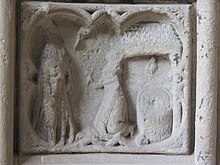
Other medical Arabic works translated into Latin during the medieval period include the works of Razi and Avicenna (including The Book of Healing and The Canon of Medicine),[58] and Ali ibn Abbas al-Majusi's medical encyclopedia, The Complete Book of the Medical Art.[24] Mark of Toledo in the early 13th century translated the Qur'an as well as various medical works.[59]
Technology and culture
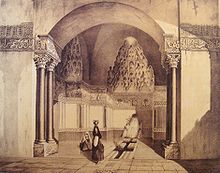
Agriculture and textiles
Various fruits and vegetables were introduced to Europe in this period via the Middle East and North Africa, some from as far as China and India, including the artichoke, spinach, and aubergine.[61]
The Arab Agricultural Revolution, which occurred between 700 and 1100, had diffused a large number of crops and technologies from Spain into medieval Europe, where farming was mostly restricted to wheat strains obtained much earlier via central Asia. The historian Andrew Watson listed eighteen crops, including sorghum from Africa, citrus fruits from China, and numerous crops from India such as mangos, rice, cotton and sugar cane, which were distributed throughout Islamic lands that, according to Watson, had previously not grown them. The introduction and diffusion of a wide range of new crops, along with an increased mechanization of agriculture, led to major changes in economy, population distribution, vegetation cover, agricultural production and income, population levels, urban growth, the distribution of the labour force, linked industries, cooking, diet and clothing in the Islamic world. Also transmitted via Muslim influence, a silk industry flourished, flax was cultivated and linen exported, and esparto grass, which grew wild in the more arid parts, was collected and turned into various articles.[62] Michael Decker, however, has suggested that four of Watson's listed crops (durum wheat, Asiatic rice, sorghum and cotton) may have been common in certain regions centuries before the Islamic period.[63]
During the Arab Agricultural Revolution, there was a dramatic change to the landscape of Islamic Spain. A whole new "system of crop rotation, fertilization, transplanting, grafting, and irrigation" was swiftly and systematically put into place under a new legal framework of land ownership and tenancy. There was thus an agricultural revolution in Al-Andalus, consisting principally of new social institutions.[64] According to D. Fairchild Ruggles, this "dramatic economic, scientific, and social transformation" began in Al-Andalus and had spread throughout the Islamic Mediterranean by the 10th century.[65]
Coffee-drinking, the earliest credible evidence of which appears in modern-day Yemen in southern Arabia in the middle of the 15th century in Sufi shrines,[66] spread to Italy. The thriving trade between Venice and North Africa, Egypt and the Middle East brought many goods, including coffee, to the Venetian port. From Venice, it was introduced to the rest of Europe. Coffee became more widely accepted after it was deemed a Christian beverage by Pope Clement VIII in 1600, despite appeals to ban the "Muslim drink." The first European coffee house opened in Rome in 1645.[67]
The origins of the cowboy tradition come from Spain, with the hacienda system of medieval Spain. Various aspects of the Spanish equestrian tradition can be traced back to Islamic rule in Spain, including Moorish elements such as the use of Oriental-type horses, the la jineta riding style characterized by a shorter stirrup, solid-treed saddle and use of spurs,[68] the heavy noseband or hackamore[69] (Arabic šakīma, Spanish jaquima),[70] and other horse-related equipment and techniques.[68][69] The earliest horses in the Americas (since the end of the prehistoric ice age) were originally of Andalusian, Barb and Arabian ancestry.[71]
Arts and architecture
Islamic decorative arts were highly valued imports to Europe throughout the Middle Ages. Largely because of accidents of survival, most surviving examples are those that were in the possession of the church. In the early period textiles were especially important, used for church vestments, shrouds, hangings and clothing for the elite. Islamic pottery of everyday quality was still preferred to European wares. Because decoration was mostly ornamental, or small hunting scenes and the like, and inscriptions were not understood, Islamic objects did not offend Christian sensibilities.[72] Medieval art in Sicily is interesting stylistically because of the mixture of Norman, Arab and Byzantine influences in areas such as mosaics and metal inlays, sculpture, and bronze-working.[73]
At least two key architectural features of Gothic architecture, the pointed arch and the rib vault, was influenced by Islamic architecture. The pointed arch, one of the defining attributes of Gothic architecture, was earlier featured in Islamic architecture.[74] Increasing military and cultural contacts with the medieval Islamic world, including the Norman conquest of Islamic Sicily in 1090, the Crusades (beginning 1096), and the Islamic presence in Spain, influenced Medieval Europe's adoption of the pointed arch.[75][76] The pointed arch was adopted from Islamic architecture by either Crusaders or via Italy.[75] Another key feature of Gothic architecutre, the rib vault, had also earlier appeared in Islamic architecture, and spread to Western Europe via Islamic Spain and Sicily.[77][78]
In those parts of the Western Mediterranean subject to Islamic control or influence, rich regional variants of Gothic architecture arose, fusing Romanesque and later Gothic traditions with Islamic decorative forms. For example, in Monreale and Cefalù Cathedrals, the Alcázar of Seville, and Teruel Cathedral.[79]
In Venetian Gothic architecture, the influence of Islamic architecture is reflected in some features of the Venetian style, in particular the use of colour and pattern on outside walls, and sometimes stone grills on windows, and perhaps purely decorative crenellations on rooflines. During the period, the Venetian economy was heavily bound up with trade with the Islamic world, and the architectural styles of the two are thus somewhat entangled.[80] Venetians also regarded some aspects of Islamic architecture as reflecting the world of Early Christianity - all over Italy "Eastern" costume very often served for Biblical figures in art, and the paintings of some Venetians, for example St Mark Preaching at Alexandria by Gentile Bellini (c. 1505) also use clearly Islamic architecture (including stone grills). There were also Venetian connections with Islamic styles though Sicily and southern Italy, and possibly Al-Andalus (Islamic Spain). Venetians probably saw the Eastern elements in their architecture in a complex way, reflecting and celebrating both their history and the cause of their trade-derived wealth.[81]
Writing and language
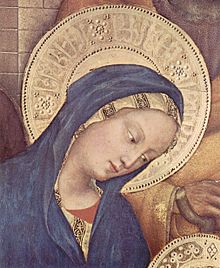
The Arabic Kufic script was often imitated for decorative effect in the West during the Middle Ages and the Renaissance, to produce what is known as pseudo-Kufic: "Imitations of Arabic in European art are often described as pseudo-Kufic, borrowing the term for an Arabic script that emphasizes straight and angular strokes, and is most commonly used in Islamic architectural decoration".[83] Numerous cases of pseudo-Kufic are known from European art from around the 10th to the 15th century; usually the characters are meaningless, though sometimes a text has been copied. Pseudo-Kufic would be used as writing or as decorative elements in textiles, religious halos or frames. Many are visible in the paintings of Giotto.[83] The exact reason for the incorporation of pseudo-Kufic in early Renaissance painting is unclear. It seems that Westerners mistakenly associated 13th- and 14th-century Middle-Eastern scripts as being identical with the scripts current during Jesus's time, and thus found natural to represent early Christians in association with them:[84] "In Renaissance art, pseudo-Kufic script was used to decorate the costumes of Old Testament heroes like David".[85] Another reason might be that artist wished to express a cultural universality for the Christian faith, by blending together various written languages, at a time when the church had strong international ambitions.[86]
Numerous Arabic words have been adopted in European languages. The influence of Arabic on the Spanish language is fundamentally lexical. It is estimated that there are about one thousand Arabic roots,[87][88] and approximately three thousand derived words, for a total of around four thousand loanwords,[87][89][90] or 8% of the Spanish dictionary,[91] the second largest lexical influence on Spanish after Latin.[92] There are also estimated to be at least more than a thousand English words of Arabic origin.[93][94]
Carpets
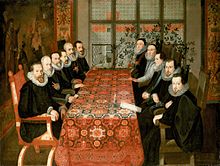
Carpets of Middle-Eastern origin, either from the Ottoman Empire, the Levant or the Mamluk state of Egypt or Northern Africa, were a significant sign of wealth and luxury in Europe, as demonstrated by their frequent occurrence as important decorative features in paintings from the 13th century and continuing into the Baroque period. Such carpets, together with Pseudo-Kufic script offer an interesting example of the integration of Eastern elements into European painting, most particularly those depicting religious subjects.[95]
Music
A number of musical instruments used in European music were influenced by Arabic musical instruments, including the rebec (an ancestor of the violin) from the rebab and the naker from naqareh.[96] Most European instruments have roots in earlier Eastern instruments that were adopted from the medieval Islamic world.[97] The Arabic rabāb, also known as the spiked fiddle, is the earliest known bowed string instrument and the ancestor of all European bowed instruments, including the rebec, the Byzantine lyra, and the violin.[98][99]
The Arabic oud in Islamic music was the direct ancestor of the European lute.[100] The oud is also cited as a precursor to the modern guitar.[101] The guitar has roots in the four-string oud, brought to Iberia by the Moors in the 8th century.[102] A direct ancestor of the modern guitar is the guitarra morisca (Moorish guitar), which was in use in Spain by 1200. By the 14th century, it was simply referred to as a guitar.[103]
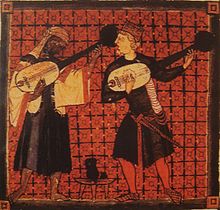
Some scholars believe that the troubadors may have had Arabian origins, with Magda Bogin stating that the Arab poetic and musical tradition was one of several influences on European "courtly love poetry".[104] Évariste Lévi-Provençal and other scholars stated that three lines of a poem by William IX of Aquitaine were in some form of Arabic, indicating a potential Andalusian origin for his works. The scholars attempted to translate the lines in question and produced various different translations; the medievalist Istvan Frank contended that the lines were not Arabic at all, but instead the result of the rewriting of the original by a later scribe.[105]
The theory that the troubadour tradition was created by William after his experiences with Moorish arts while fighting with the Reconquista in Spain has been championed by Ramón Menéndez Pidal and Idries Shah, though George T. Beech states that there is only one documented battle that William fought in Spain, and it occurred towards the end of his life. However, Beech adds that William and his father did have Spanish individuals within their extended family, and that while there is no evidence he himself knew Arabic, he may have been friendly with some European Christians who could speak the language.[105] Others state that the notion that William created the concept of troubadours is itself incorrect, and that his "songs represent not the beginnings of a tradition but summits of achievement in that tradition."[106]
Technology
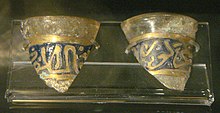
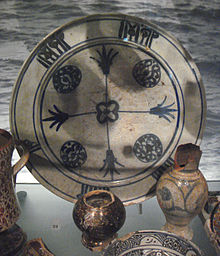
A number of technologies in the Islamic world were adopted in European medieval technology. These included various crops;[62] various astronomical instruments, including the Greek astrolabe which Arab astronomers developed and refined into such instruments as the Quadrans Vetus, a universal horary quadrant which could be used for any latitude,[107] and the Saphaea, a universal astrolabe invented by Abū Ishāq Ibrāhīm al-Zarqālī;[108] the astronomical sextant; various surgical instruments, including refinements on older forms and completely new inventions;[57] and advanced gearing in waterclocks and automata.[109] Distillation was known to the Greeks and Romans, but was rediscovered in medieval Europe through the Arabs.[110] The word alcohol (to describe the liquid produced by distillation) comes from Arabic al-kuhl.[111] The word alembic (via the Greek Ambix) comes from Arabic al-anbiq.[112] Islamic examples of complex water clocks and automata are believed to have strongly influenced the European craftsmen who produced the first mechanical clocks in the 13th century.[113]
The importation of both the ancient and new technology from the Middle East and the Orient to Renaissance Europe represented “one of the largest technology transfers in world history.”[114]
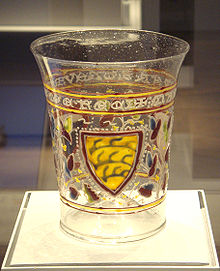
The production of sugar from sugar cane,[116] water clocks, pulp and paper, silk, and various advances in making perfume, were transferred from the Islamic world to medieval Europe.[117] Fulling mills and advances in mill technology may have also been transmitted from the Islamic world to medieval Europe,[118] along with the large-scale use of inventions like the suction pump,[119] noria and chain pumps for irrigation purposes. According to Watson, "The Islamic contribution was less in the invention of new devices than in the application on a much wider scale of devices which in pre-Islamic times had been used only over limited areas and to a limited extent."[120] These innovations made it possible for some industrial operations that were previously served by manual labour or draught animals to be driven by machinery in medieval Europe.[121]
The process of alcohol distillation (liquor), which Al-Kindi unambiguously described in the 9th century,[122][123][124] spread to Italy,[122][125] where the distillation of alcohol later appeared at the School of Salerno in southern Italy during the 12th century.[126][127]
Coinage

While the earliest coins were minted and widely circulated in Europe, and Ancient Rome, Islamic coinage had some influence on Medieval European minting. The 8th-century English king Offa of Mercia minted a near-copy of Abbasid dinars struck in 774 by Caliph Al-Mansur with "Offa Rex" centered on the reverse.[128] The moneyer visibly had little understanding of Arabic, as the Arabic text contains a number of errors.
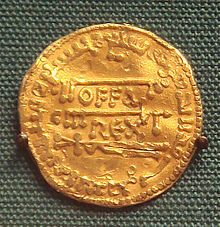

In Sicily, Malta and Southern Italy from about 913 tarì gold coins of Islamic origin were minted in great number by the Normans, Hohenstaufens and the early Angevins rulers.[130] When the Normans invaded Sicily in the 12th century, they issued tarì coins bearing legends in Arabic and Latin.[131] The tarìs were so widespread that imitations were made in southern Italy (Amalfi and Salerno) which only used illegible "pseudo-Kufic" imitations of Arabic.[132][133]
According to Janet Abu-Lughod:
The preferred specie for international transactions before the 13th century, in Europe as well as the Middle East and even India, were the gold coins struck by Byzantium and then Egypt. It was not until after the 13th century that some Italian cities (Florence and Genoa) began to mint their own gold coins, but these were used to supplement rather than supplant the Middle Eastern coins already in circulation.[134]
Institutions
Early medieval universities in Europe are believed to have been influenced by Islamic madrasas in Al-Andalus, the Emirate of Sicily, and the Middle East during the Crusades.[135][136][137] The influences of scholarship from the Islamic world on the universities of Western Europe are well-documented.[138] Their endowment by a prince or monarch and their role in training government officials made early Mediterranean universities similar to Islamic madrasas.[139] Madaris and European universities in the Mediterranean region shared similar foundations by princely patrons and were intended to provide loyal administrators to further the rulers' agenda.[140] According to historians such as George Makdisi, Devin J. Stewart, Josef W. Meri, and Shawkat Toorawa, the ijazah issued in early Islamic madrasahs was a direct precursor to, and influenced, the doctorate later issued in medieval universities.[141][142]
Several legal institutions developed by Muslim jurists during the classical period of Islam are believed to have influenced similar legal institutions in Europe. One such institution was the Hawala, an early informal value transfer system, which is mentioned in texts of Islamic jurisprudence as early as the 8th century. Hawala itself later influenced the development of the agency in common law and in civil laws such as the aval in French law and the avallo in Italian law.[143] The "European commenda" (Islamic Qirad) used in European civil law may have also originated from Islamic law.[144] The Waqf in Islamic law, which developed during the 7th–9th centuries, bears a notable resemblance to the trusts in the English trust law.[145] For example, every Waqf was required to have a waqif (settlor), mutawillis (trustee), qadi (judge) and beneficiaries.[146] The trust law developed in England at the time of the Crusades, during the 12th and 13th centuries, was introduced by Crusaders who may have been influenced by the Waqf institutions they came across in the Middle East.[147][148]
The Islamic lafif was a body of twelve members drawn from the neighbourhood and sworn to tell the truth, who were bound to give a unanimous verdict, about matters "which they had personally seen or heard, binding on the judge, to settle the truth concerning facts in a case, between ordinary people, and obtained as of right by the plaintiff." According to Professor John Makdisi, "no other institution in any legal institution studied to date shares all of these characteristics with the English jury." It is thus likely that the concept of the lafif may have been introduced to England by the Normans, who conquered both England and the Emirate of Sicily, and then evolved into the modern English jury.[144]
Literature
It was first suggested by Miguel Asín Palacios in 1919 that Dante Alighieri's Divine Comedy, considered the greatest epic of Italian literature, derived many features of and episodes about the hereafter directly or indirectly from Arabic works on Islamic eschatology, such as the Hadith and the spiritual writings of Ibn Arabi. The Kitab al-Miraj, concerning Muhammad's ascension to Heaven, was translated into Latin in 1264 or shortly before[149] as Liber Scale Machometi, "The Book of Muhammad's Ladder". Dante was certainly aware of Muslim philosophy, naming Avicenna and Averroes last in his list of non-Christian philosophers in Limbo, alongside the great Greek and Latin philosophers.[150][151] How strong the similarities are to Kitab al-Miraj remains a matter of scholarly debate however, with no clear evidence that Dante was in fact influenced.
See also
- Hindu and Buddhist contribution to science in medieval Islam
- Reception of Islam in Early Modern Europe
- Renaissance of the 12th century
Notes
- ^ A few of the Latin works are now attributed to a Pseudo-Geber, as although attributed to "Geber", they have no identified Arabic source and appear to have been composed in Latin in the 13th century.[31]
References
- ^ a b c Lebedel, p.109
- ^ Lebedel, p.113
- ^ Lewis, p.148
- ^ Lebedel, p.109–111
- ^ Ghazanfar, Shaikh M. (2007). Medieval Islamic economic thought: filling the "great gap" in European economics. Psychology Press. p. 126. ISBN 978-0-415-44451-4.
- ^ Herbermann, Charles, ed. (1913). . Catholic Encyclopedia. New York: Robert Appleton Company.
- ^ Herbermann, Charles, ed. (1913). . Catholic Encyclopedia. New York: Robert Appleton Company.
- ^ a b Majid Fakhry (2001). Averroes: His Life, Works and Influence p. 135 Oneworld Publications. ISBN 1-85168-269-4.
- ^ "Avicenna", Lenn Evan Goodman, 2006, p. 209
- ^ Leaman, Oliver (2013). History of Islamic Philosophy. Routledge. pp. 1017–1019. ISBN 978-1-136-78044-8.
- ^ Corbin, History of Islamic Philosophy (1993), p.174
- ^ Irwin, Jones (Autumn 2002), "Averroes' Reason: A Medieval Tale of Christianity and Islam", The Philosopher, LXXXX (2)
- ^ "Inventions et decouvertes au Moyen-Age", Samuel Sadaune, p.112
- ^ Ormsby, Eric. "Averroes (Ibn Rushd): His Life, Works and Influence". H-Net Reviews. "The Influence of Islamic Thought on Maimonides". Stanford Encyclopedia of Philosophy. 27 November 2016. According to Margaret Smith (1944), "There can be no doubt that Ghazali’s works would be among the first to attract the attention of these European scholars" and "The greatest of these Christian writers who was influenced by Al-Ghazali was St. Thomas Aquinas (1225–1274), who made a study of the Islamic writers and admitted his indebtedness to them. He studied at the University of Naples where the influence of Islamic literature and culture was predominant at the time." Margaret Smith, Al-Ghazali: The Mystic (London 1944)
- ^ Makdisi, George (April–June 1989), "Scholasticism and Humanism in Classical Islam and the Christian West", Journal of the American Oriental Society, 109 (2), Journal of the American Oriental Society, Vol. 109, No. 2: 175–182, doi:10.2307/604423, JSTOR 604423
- ^ Fielding H. Garrison, An Introduction to the History of Medicine: with Medical Chronology, Suggestions for Study and Biblographic Data, p. 86
- ^ Lebedel, p.111
- ^ Lebedel, p.112
- ^ C. Burnett, "Arabic-Latin Translation Program in Toledo", p. 255.
- ^ C. H. Haskins, Studies in the History of Mediaeval Science, pp.3-4
- ^ R. W. Southern, The Making of the Middle Ages, p.65
- ^ a b c V. J. Katz, A History of Mathematics: An Introduction, p. 291.
- ^ For a list of Gerard of Cremona's translations see: Edward Grant (1974) A Source Book in Medieval Science, (Cambridge: Harvard Univ. Pr.), pp. 35–38 or Charles Burnett, "The Coherence of the Arabic-Latin Translation Program in Toledo in the Twelfth Century," Science in Context, 14 (2001): at 249–288, at pp. 275–281.
- ^ a b c d e f Bieber, Jerome B. "Medieval Translation Table 2: Arabic Sources". Santa Fe Community College. Archived from the original on March 18, 2001.
{{cite web}}: Unknown parameter|deadurl=ignored (|url-status=suggested) (help) - ^ D. Campbell, Arabian Medicine and Its Influence on the Middle Ages, p. 6.
- ^ A. C. Crombie, Robert Grosseteste and the Origins of Experimental Science, 1100–1700, (Oxford: Clarendon Press, 1971), pp. 52–60.
- ^ Ackerman, James S. (1978), "Leonardo's Eye", Journal of the Warburg & Courtauld Institutes, vol. Vol. 41, p. 119
{{citation}}:|volume=has extra text (help) - ^ Debus, Allen G. (2002). The Chemical Philosophy: Paraclesian Science and Medicine in the Sixteenth and Seventeenth Centuries. Dover Publ. p. 11. ISBN 0486421759.
- ^ Eric John Holmyard, Alchemy, p.106
- ^ Eric John Holmyard, Alchemy, p.109
- ^ Eric John Holmyard, Alchemy, pp.134-135
- ^ "the definition of alkali". Dictionary.com. Retrieved 8 April 2018.
- ^ a b Katz, Victor J., ed. (2007), The mathematics of Egypt, Mesopotamia, China, India, and Islam: a sourcebook, Princeton University Press, ISBN 978-0-691-11485-9, p.4
- ^ G. G. Joseph, The Crest of the Peacock, p. 306
- ^ Gill, M. (2005). "Was Muslim Astronomy the Harbinger of Copernicanism?". Archived from the original on 2 January 2008. Retrieved 2008-01-22.
{{cite web}}: Unknown parameter|deadurl=ignored (|url-status=suggested) (help) - ^ David Pingree (1964), "Gregory Chioniades and Palaeologan Astronomy", Dumbarton Oaks Papers 18, p. 135–160.
- ^ O'Connor, John J.; Robertson, Edmund F., "Abu Abd Allah Muhammad ibn Muadh Al-Jayyani", MacTutor History of Mathematics Archive, University of St Andrews
- ^ Burnett, Charles (1997), The introduction of Arabic learning into England (null ed.), London: British Library, p. 5, ISBN 978-0-7123-4545-3
- ^ Fulbert of Chartres (1976). Frederick Behrends (ed.). The letters and poems of Fulbert of Chartres. Translated by Behrends (Reproduction ed.). Oxford: Clarendon Press. p. 261. ISBN 978-0-19-822233-0. Retrieved 14 May 2011.
- ^ Sabra, A. I.; Hogendijk, J. P. (2003), The Enterprise of Science in Islam: New Perspectives, MIT Press, pp. 85–118, ISBN 0-262-19482-1, OCLC 237875424
- ^ H. Salih, M. Al-Amri, M. El Gomati (2005). "The Miracle of Light", A World of Science 3 (3), UNESCO
- ^ Marshall, Peter (September 1981), "Nicole Oresme on the Nature, Reflection, and Speed of Light", Isis, 72 (3): 357–374 [367–374], doi:10.1086/352787
- ^ a b Richard Powers (University of Illinois), Best Idea; Eyes Wide Open Archived 2008-02-29 at the Wayback Machine, New York Times, April 18, 1999.
- ^ a b Falco, Charles M. (12–15 February 2007), Ibn al-Haytham and the Origins of Modern Image Analysis, International Conference on Information Sciences, Signal Processing and its Applications
- ^ "John Buridan > Notes (Stanford Encyclopedia of Philosophy)". plato.stanford.edu. Retrieved 8 April 2018.
- ^ Pines, Shlomo (1970). "Abu'l-Barakāt al-Baghdādī , Hibat Allah". Dictionary of Scientific Biography. Vol. 1. New York: Charles Scribner's Sons. pp. 26–28. ISBN 0-684-10114-9.
(cf. Abel B. Franco (October 2003). "Avempace, Projectile Motion, and Impetus Theory", Journal of the History of Ideas 64 (4), p. 521-546 [528].) - ^ Gutman, Oliver (2003). Pseudo-Avicenna, Liber Celi Et Mundi: A Critical Edition. Brill Publishers. p. 193. ISBN 90-04-13228-7.
- ^ Moody, Ernest A. (1951), "Galileo and Avempace: The Dynamics of the Leaning Tower Experiment (I)", Journal of the History of Ideas 12 (2): 163–193
- ^ Franco, Abel B.. "Avempace, Projectile Motion, and Impetus Theory". Journal of the History of Ideas. Vol. 64(4): 543.
- ^ Schmidl, Petra G. (1996–1997). "Two Early Arabic Sources On The Magnetic Compass". Journal of Arabic and Islamic Studies. 1: 81–132.
- ^ Christoph Kann (1993). "Michael Scotus". In Bautz, Traugott (ed.). Biographisch-Bibliographisches Kirchenlexikon (BBKL) (in German). Vol. 5. Herzberg: Bautz. cols. 1459–1461. ISBN 3-88309-043-3.
- ^ Charles Burnett, ed. Adelard of Bath, Conversations with His Nephew, (Cambridge: Cambridge University Press, 1999), p. xi.
- ^ "Inventions et decouvertes au Moyen-Age", Samuel Sadaune, p.44
- ^ National Library of Medicine digital archives
- ^ David W. Tschanz, MSPH, PhD (August 2003). "Arab Roots of European Medicine", Heart Views 4 (2).
- ^ D. Campbell, Arabian Medicine and Its Influence on the Middle Ages, p. 3.
- ^ a b Albucasis Science museum on Albucasis
- ^ M.-T. d'Alverny, "Translations and Translators," pp. 444–446, 451
- ^ M.-T. d'Alverny, "Translations and Translators," pp. 429, 455
- ^ "Les Normans en Sicile"
- ^ Roux, p. 47
- ^ a b Andrew M. Watson (1974), "The Arab Agricultural Revolution and Its Diffusion, 700–1100", The Journal of Economic History 34 (1), pp. 8–35.
- ^ Michael Decker: "Plants and Progress: Rethinking the Islamic Agricultural Revolution", Journal of World History, Vol. 20, No. 2 (2009), pp. 187-206
- ^ Ruggles 2000, pp. 31–32.
- ^ Ruggles 2008, p. 36.
- ^ Weinberg, Bennett Alan; Bealer, Bonnie K. (2001). The World of Caffeine: The Science and Culture of the World's Most Popular Drug. New York: Routledge. pp. 3–4. ISBN 978-0-415-92722-2. Retrieved November 18, 2015.
{{cite book}}: CS1 maint: ref duplicates default (link) - ^ Meyers, Hannah (March 7, 2005). "Suave Molecules of Mocha—Coffee, Chemistry, and Civilization". New Partisan. New Partisan. Archived from the original on March 22, 2011.
- ^ a b Metin Boşnak, Cem Ceyhan (Fall 2003). "Riding the Horse, Writing the Cultural Myth: The European Knight and the American Cowboy as Equestrian Heroes". Turkish Journal of International Relations. 2 (1): 157–81.
- ^ a b Bennett, pp. 54–55
- ^ "hackamore." The American Heritage Dictionary of the English Language, Fourth Edition. Houghton Mifflin Company, 2004. 24 Feb. 2008. Dictionary.com
- ^ Denhardt, Robert M. The Horse of the Americas Norman: University of Oklahoma Press 1947, p. 20.
- ^ Mack, 3-8, and throughout
- ^ Aubé, Pierre (2006). Les empires normands d’Orient. Editions Perrin. pp. 164–165. ISBN 2262022976.
- ^ Banister Fletcher, A History of Architecture on the Comparative Method.
- ^ a b Scott, Robert A. (2003). The Gothic enterprise: a guide to understanding the Medieval cathedral. University of California Press. p. 113. ISBN 978-0-520-23177-1.
- ^ Bony, Jean (1983). French Gothic Architecture of the Twelfth and Thirteenth Centuries. University of California Press. p. 17. ISBN 978-0-520-02831-9.
- ^ Giese-Vögeli, Francine (2007). Das islamische Rippengewölbe : Ursprung, Form, Verbreitung [Islamic rib vaults: Origins, form, spread]. Berlin: Gebr. Mann. ISBN 978-3-7861-2550-1.
- ^ Bloom, Jonathan M. (2017-05-15). Early Islamic Art and Architecture. Routledge. p. 69. ISBN 9781351942584.
- ^ Harvey, L. P. (1992). "Islamic Spain, 1250 to 1500." Chicago : University of Chicago Press. ISBN 0-226-31960-1; Boswell, John (1978). Royal Treasure: Muslim Communities Under the Crown of Aragon in the Fourteenth Century. Yale University Press. ISBN 0-300-02090-2.
- ^ Mack, Rosamond E., Bazaar to Piazza, 2002, University of California Press, ISBN 9790520221313 Parameter error in {{ISBN}}: invalid group id, Google Books, pages 8-12
- ^ Mack, Rosamond E., Bazaar to Piazza, 2002, University of California Press, ISBN 9790520221313 Parameter error in {{ISBN}}: invalid group id, Google Books, pages 8-13
- ^ Mack, p.65–66
- ^ a b Mack, p.51
- ^ Mack, p.52, p.69
- ^ Frieder, Braden K. (2008). Chivalry & the Perfect Prince: Tournaments, Art, and Armor at the Spanish Habsburg Court. Truman State University Press. p. 84. ISBN 978-1-931112-69-7.
- ^ "Perhaps they marked the imagery of a universal faith, an artistic intention consistent with the Church's contemporary international program." Mack, p.69
- ^ a b Dworkin, Steven N. (2012). A History of the Spanish Lexicon: A Linguistic Perspective. Oxford: Oxford University Press. p. 83. ISBN 0199541140.
- ^ Martínez Egido, José Joaquín (2007). Constitución del léxico español. p. 15.
- ^ Versteegh, Kees (2003). The Arabic language (Repr. ed.). Edinburgh: Edinburgh University Press. p. 228. ISBN 0748614362.
- ^ Lapesa, Raphael (1960). Historia de la lengua española. Madrid. p. 97.
{{cite book}}: CS1 maint: location missing publisher (link) - ^ Quintana, Lucía; Mora, Juan Pablo (2002). "Enseñanza del acervo léxico árabe de la lengua española" (PDF). ASELE. Actas XIII: 705.: "El léxico español de procedencia árabe es muy abundante: se ha señalado que constituye, aproximadamente, un 8% del vocabulario total"
- ^ Macpherson, I. R. (1980). Spanish phonology. Manchester: Manchester University Press. p. 93. ISBN 0719007887.
- ^ Beg, Muhammad Abdul Jabbar (1983). Arabic loan-words in Malay: a comparative study (a survey of Arabic and Islamic influence upon the languages of mankind). University of Malaya Press. p. 46. ISBN 9789679990010.
The Arabic loan-words in English arc about a thousand in number (excluding derivatives), and when collected together under subject-headings form picturesque- groups.
- ^ Yacoub, Mohamed Ahmed (2015). "Do Ten Thousand Arabic Loanwords Truly Exist In English?". International Journal of Interdisciplinary Research and Innovations. 3 (1): 102–106.
- ^ Lessing, Julius (1879) [1877]. Altorientalische Teppichmuster: Nach Bildern und Originalen des XV. - XVI. Jahrhunderts, translated into English as Ancient Oriental Carpet Patterns after Pictures and Originals of the Fifteenth and Sixteenth Centuries. London: H. Sotheran.
- ^ (Farmer 1988, p. 137)
- ^ Sachs, Curt (1940), The History of Musical Instruments, Dover Publications, p. 260, ISBN 978-0-486-45265-4
- ^ "rabab (musical instrument) - Encyclopædia Britannica". Britannica.com. Retrieved 2013-08-17.
- ^ Encyclopædia Britannica (2009), lira, Encyclopædia Britannica Online, retrieved 2009-02-20
- ^ "ʿūd | musical instrument". Encyclopedia Britannica. Retrieved 6 April 2019.
- ^ Summerfield, Maurice J. (2003). "Its Evolution". The Classical Guitar: Its Evolution, Players and Personalities Since 1800 (5th ed.). Ashley Mark. ISBN 1872639461.
- ^ Summerfield, Maurice J. (2003). The Classical Guitar: Its Evolution, Players and Personalities Since 1800 (5th ed.). Blaydon on Tyne: Ashley Mark. ISBN 1872639461.
- ^ Tom and Mary Anne Evans. Guitars: From the Renaissance to Rock. Paddington Press Ltd 1977 p.16
- ^ Bogin, Magda; Bogin, Meg (1995). The Women Troubadours. WW Norton. ISBN 978-0393009651.
- ^ a b Beech, George T. (1992). "Troubadour Contacts with Muslim Spain and Knowledge of Arabic : New Evidence Concerning William IX of Aquitaine". Romania: 14-26.
- ^ Peter Dronke, The Medieval Lyric, Perennial Library, 1968. p. 111.
- ^ David A. King (2002). "A Vetustissimus Arabic Text on the Quadrans Vetus", Journal for the History of Astronomy 33, p. 237–255 [237–238].
- ^ The Saphea Arzachelis Archived 2011-07-25 at the Wayback Machine, astrolabes.org
- ^ Ahmad Y Hassan, Transfer Of Islamic Technology To The West, Part II: Transmission Of Islamic Engineering Archived 2008-02-18 at the Wayback Machine, History of Science and Technology in Islam
- ^ "Liquid fire". The Economist. 18 December 2003. Retrieved 27 November 2016.
legacy of Islamic civilisation is ... the rather unholy art of distilling alcohol ... Aristotle described a way of vaporising salt water into fresh, the Romans distilled turpentine from pine oil ...
- ^ Thomas Nordegren. The A-Z Encyclopedia of Alcohol and Drug Abuse. p. 38.
- ^ Chambers's encyclopaedia: a dictionary of universal knowledge, Volume 1. J.B. Lippincott & Co. 1888. p. 142.
- ^ "Studies in Medieval Islamic Technology: From Philo to Al-Jazari - From Alexandria to Diya Bakr", Donald Routledge Hill and David A. King, p.23, 1998, ISBN 978-0-86078-606-1
- ^ "History of Europe". britannica.com. Retrieved 8 April 2018.
- ^ "Examining the enamel on the Aldrevandini beaker". British Museum.
- ^ "The Sugar Cane Industry: An Historical Geography from Its Origins to 1914 (1989)", pp.34-34, JH Galloway, ISBN 0-521-02219-3
- ^ Ahmad Y Hassan, Transfer Of Islamic Technology To The West, Part 1: Avenues Of Technology Transfer Archived 2009-09-26 at the Wayback Machine
- ^ Adam Lucas (2006), Wind, Water, Work: Ancient and Medieval Milling Technology, p. 10 & 65, BRILL, ISBN 90-04-14649-0.
- ^ Ahmad Y Hassan. The Origin of the Suction Pump Archived 2008-02-26 at the Wayback Machine.
- ^ Quoted in "The Sugar Cane Industry: An Historical Geography from Its Origins to 1914", JH Galloway, p. 27
- ^ Adam Robert Lucas (2005), "Industrial Milling in the Ancient and Medieval Worlds: A Survey of the Evidence for an Industrial Revolution in Medieval Europe", Technology and Culture 46 (1), pp. 1–30.
- ^ a b Ahmad Y. al-Hassan (2001), Science and Technology in Islam: Technology and applied sciences, pages 65-69, UNESCO
- ^ Hassan, Ahmad Y. "Alcohol and the Distillation of Wine in Arabic Sources". History of Science and Technology in Islam. Retrieved 2014-04-19.
- ^ The Economist: "Liquid fire - The Arabs discovered how to distil alcohol. They still do it best, say some" December 18, 2003
- ^ Irfan Habib (2011), Economic History of Medieval India, 1200-1500, page 55, Pearson Education
- ^ Forbes, Robert James (1970). A short history of the art of distillation: from the beginnings up to the death of Cellier Blumenthal. BRILL. pp. 57, 89. ISBN 978-90-04-00617-1. Retrieved 29 June 2010.
- ^ Sarton, George (1975). Introduction to the history of science. R. E. Krieger Pub. Co. p. 145.
- ^ British Museum
- ^ "Gold imitation dinar of Offa". British Museum.
- ^ Blanchard, Ian Mining, Metallurgy and Minting in the Middle Ages Franz Steiner Verlag, 2001 ISBN 978-3-515-07958-7 [1], p.196
- ^ British Museum, Islamic Art room
- ^ Cardini, Franco Europe and Islam Blackwell Publishing, 2001 ISBN 978-0-631-22637-6 [2], p.26
- ^ Grierson, Philip Medieval European Coinage Cambridge University Press, 1998. ISBN 978-0-521-58231-5 [3], p.3
- ^ Janet Abu-Lughod Before European Hegemony, The World System A.D. 1250–1350, Oxford University Press, ISBN 0-19-506774-6 p.15
- ^ Nuria Sanz, Sjur Bergan (1 January 2006). The heritage of European universities, Volume 548. Council of Europe. p. 28. ISBN 9789287161215. Archived from the original on 5 September 2015.
{{cite book}}: Unknown parameter|deadurl=ignored (|url-status=suggested) (help) - ^ Makdisi, George (April–June 1989). "Scholasticism and Humanism in Classical Islam and the Christian West". Journal of the American Oriental Society. 109 (2): 175–182 [175–77]. Bibcode:1964JAOS...84..128H. doi:10.2307/604423. JSTOR 604423.; Makdisi, John A. (June 1999). "The Islamic Origins of the Common Law". North Carolina Law Review. 77 (5): 1635–1739.
- ^ Goddard, Hugh (2000). A History of Christian-Muslim Relations. Edinburgh University Press. p. 99. ISBN 978-0-7486-1009-9.
- ^ Lowe, Roy; Yasuhara, Yoshihito (2013), "The origins of higher learning: time for a new historiography?", in Feingold, Mordecai (ed.), History of Universities, vol. 27, Oxford: Oxford University Press, pp. 1–19, ISBN 9780199685844, archived from the original on 5 September 2015
{{citation}}: Unknown parameter|deadurl=ignored (|url-status=suggested) (help) - ^ Pryds, Darleen (2000), "Studia as Royal Offices: Mediterranean Universities of Medieval Europe", in Courtenay, William J.; Miethke, Jürgen; Priest, David B. (eds.), Universities and Schooling in Medieval Society, Education and Society in the Middle Ages and Renaissance, vol. 10, Leiden: Brill, pp. 96–98
- ^ Pryds, Darleen (2000), "Studia as Royal Offices: Mediterranean Universities of Medieval Europe", in Courtenay, William J.; Miethke, Jürgen; Priest, David B. (eds.), Universities and Schooling in Medieval Society, Education and Society in the Middle Ages and Renaissance, vol. 10, Leiden: Brill, pp. 83–99, ISBN 978-90-04-11351-0, ISSN 0926-6070
- ^ Makdisi, George (April–June 1989), "Scholasticism and Humanism in Classical Islam and the Christian West", Journal of the American Oriental Society, 109 (2): 175–182 [175–77], doi:10.2307/604423, JSTOR 604423
- ^ Devin J. Stewart, Josef W. Meri (2005). Degrees, or Ijazah. Routledge. pp. 201–203. ISBN 9781135455965.
{{cite book}}:|journal=ignored (help) - ^ Badr, Gamal Moursi (Spring 1978). "Islamic Law: Its Relation to Other Legal Systems". The American Journal of Comparative Law. 26 (2 – Proceedings of an International Conference on Comparative Law, Salt Lake City, Utah, 24–25 February 1977). American Society of Comparative Law: 187–198 [196–98]. doi:10.2307/839667. JSTOR 839667.
- ^ a b Makdisi, John A. (June 1999). "The Islamic Origins of the Common Law". North Carolina Law Review. 77 (5): 1635–1739.
- ^ Gaudiosi, Monica M (April 1988). "The Influence of the Islamic Law of Waqf on the Development of the Trust in England_ The Case of Merton College". University of Pennsylvania Law Review. 136 (4). The University of Pennsylvania Law Review: 1231–1261. doi:10.2307/3312162. JSTOR 3312162.
- ^ Gaudiosi, Monica M (April 1988). "The Influence of the Islamic Law of Waqf on the Development of the Trust in England_ The Case of Merton College". University of Pennsylvania Law Review. 136 (4). The University of Pennsylvania Law Review: 1237–40. doi:10.2307/3312162. JSTOR 3312162.
- ^ Hudson 2003, p. 32
- ^ Gaudiosi, Monica M (April 1988). "The Influence of the Islamic Law of Waqf on the Development of the Trust in England_ The Case of Merton College". University of Pennsylvania Law Review. 136 (4). The University of Pennsylvania Law Review: 1244–45. doi:10.2307/3312162. JSTOR 3312162.
- ^ I. Heullant-Donat and M.-A. Polo de Beaulieu, "Histoire d'une traduction," in Le Livre de l'échelle de Mahomet, Latin edition and French translation by Gisèle Besson and Michèle Brossard-Dandré, Collection Lettres Gothiques, Le Livre de Poche, 1991, p. 22 with note 37.
- ^ "Paul A. (Paul Arthur) Cantor - The Uncanonical Dante: The Divine Comedy and Islamic Philosophy - Philosophy and Literature 20:1". www.muslimphilosophy.com. Retrieved 8 April 2018.
- ^ Alighieri, Dante. "The Divine Comedy". Retrieved 8 April 2018 – via Wikisource.
Sources
- Attar, Samar (2007), The vital roots of European enlightenment : Ibn Tufayl's influence on modern Western thought, Lanham: Lexington Books, ISBN 0-7391-1989-3
- Badr, Gamal Moursi (Spring 1978), "Islamic Law: Its Relation to Other Legal Systems", The American Journal of Comparative Law, 26 (2 [Proceedings of an International Conference on Comparative Law, Salt Lake City, Utah, February 24–25, 1977]), The American Journal of Comparative Law, Vol. 26, No. 2: 187–198, doi:10.2307/839667, JSTOR 839667
- Cardini, Franco. Europe and Islam. Blackwell Publishing, 2001. ISBN 978-0-631-22637-6
- Farmer, Henry George (1988), Historical facts for the Arabian Musical Influence, Ayer Publishing, ISBN 0-405-08496-X, OCLC 220811631
- Frieder, Braden K. Chivalry & the perfect prince: tournaments, art, and armor at the Spanish Habsburg court Truman State University, 2008 ISBN 1-931112-69-X, ISBN 978-1-931112-69-7
- Grierson, Philip Medieval European Coinage Cambridge University Press, 2007 ISBN 0-521-03177-X, ISBN 978-0-521-03177-6
- Hobson, John M. (2004), The Eastern Origins of Western Civilisation, Cambridge: Cambridge Univ. Press, ISBN 0-521-54724-5
- Lebedel, Claude (2006), Les Croisades, origines et conséquences, Editions Ouest-France, ISBN 2-7373-4136-1, OCLC 181885553
- Lewis, Bernard (1993), Les Arabes dans l'histoire, Flammarion, ISBN 2-08-081362-5, OCLC 36229500
- Mack, Rosamond E. Bazaar to Piazza: Islamic Trade and Italian Art, 1300–1600, University of California Press, 2001 ISBN 0-520-22131-1, google books
- Makdisi, John A. (June 1999), "The Islamic Origins of the Common Law", North Carolina Law Review, 77 (5): 1635–1739
- Matthew, Donald, The Norman kingdom of Sicily Cambridge University Press, 1992 ISBN 978-0-521-26911-7
- Roux, Jean-Paul (1985), Les explorateurs au Moyen-Age, Hachette, ISBN 2-01-279339-8
- Watt, W. Montgomery (2004), The influence of Islam on medieval Europe, Edinburgh: Edinburgh University Press, ISBN 0-7486-0517-7
External links
- Zalta, Edward N. (ed.). "Influence of Arabic and Islamic Philosophy on the Latin West". Stanford Encyclopedia of Philosophy.
- Islamic Contributions to the West by Rachida El Diwani, Professor of Comparative Literature.
- "How Greek Science Passed to the Arabs" by De Lacy O'Leary
- Islamic Contributions to Civilization by Stanwood Cobb (1963)

